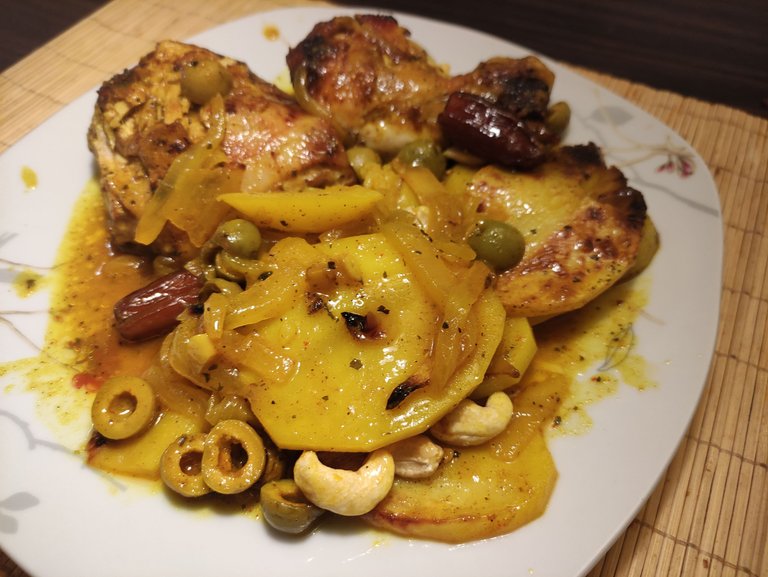Food review: Moroccan edition! 🇲🇦
Let's eat at the restaurant owned by the
favorite Chef of the late King Hassan II in Marrakech.
Vamos a comer en el restaurante que lleva el Chef preferido del difunto
Rey Hassan II en Marrakech.
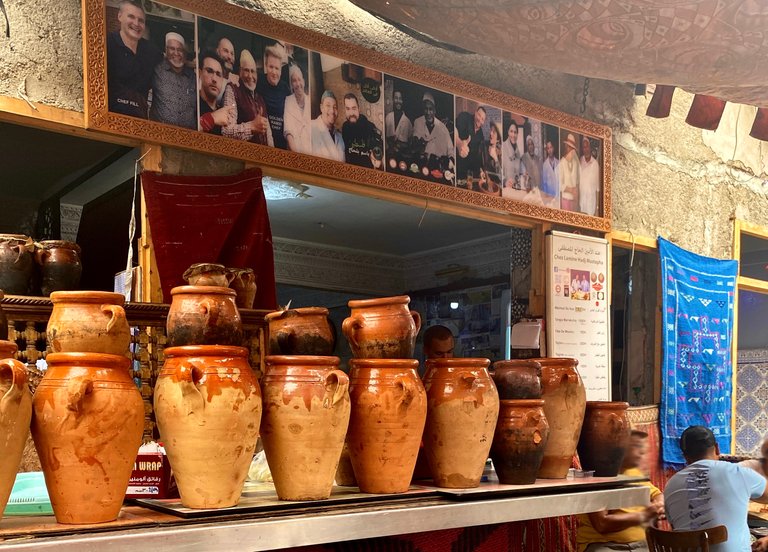
Moroccan food
Derb Semmarine, Marrakech. Morocco
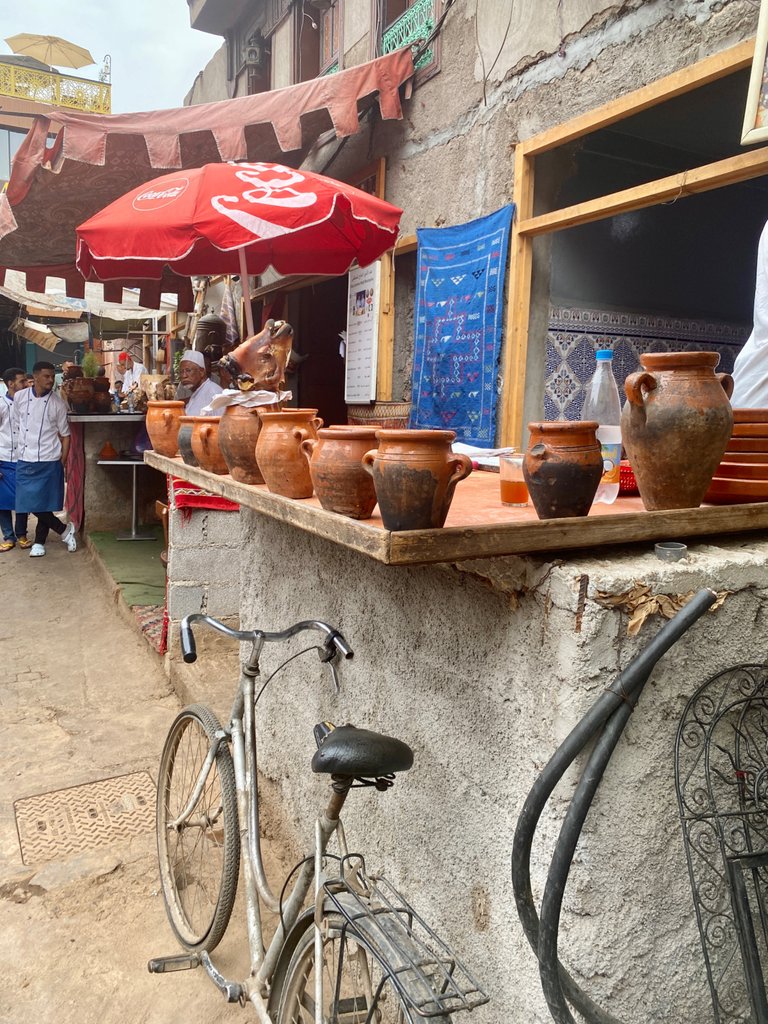
When we think of Moroccan food, the first thing that comes to mind is cous cous and the famous tajin, so striking for the shape of the clay pot not only where it is cooked but also where it is served.
But in Marrakech there is a signature dish that is none of these, I refer to the Tangia Marrakchia, the most typical dish and hardly available outside the city.
Around 13:00 hours all Marrakech is filled with the aroma of their food and in many street food stalls you can see small earthenware pots with signs of having been subjected to fire for a long time.
And so it is, because this emblematic dish is usually simmered in the ashes of large ovens used to heat water. The advantage of this cooking method is that the result is a very tender meat, full of the flavor of the spices and pickled lemon with which it is cooked.
Cuando pensamos en la comida de Marruecos, lo primero que viene a nuestra mente es el cuscús y el famoso tajín, tan llamativo por la forma del recipiente de barro no solo donde se cocina sino en donde se sirve.
Pero en Marrakech hay un plato insigne que no es ninguno de estos, me refiero a la Tangia Marrakchia, el plato más típico y que difícilmente se consigue fuera de la ciudad.
Cerca de las 13:00 horas todo Marrakech se llena del aroma de sus comidas y en muchos puestos de comida callejera se ven pequeños jarrones de barro con muestras de haber estado mucho tiempo sometidos al fuego.
Y así es, pues este emblemático plato suele cocerse a fuego lento entre las cenizas de grandes hornos utilizados para calentar agua. La ventaja de este método de cocción es que el resultado es una carne muy tierna y llena del sabor de las especias y el limón encurtido con el que se cocina.
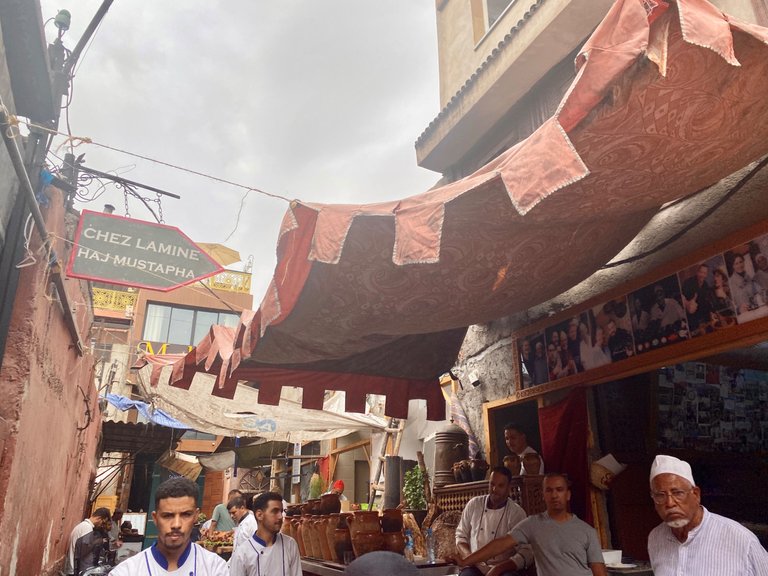
But as this is not enough, there is also a place highly valued by both locals and world gastronomy experts who reiterate that it is essential to go there. Close to the huge Jemaa el-Fna square and well located in the Méchoui Alley, so called because of the large number of restaurants dedicated to this dish, which is a roast lamb prepared in a very peculiar way.
I am referring to Chez Lamine, a seemingly small and simple restaurant where they are dedicated to offer the food of the land, specializing in lamb and various roasts prepared by traditional method, without altering the recipes of a lifetime, thus being a reference for many international chefs who have come there to learn the basics of Moroccan food.
The restaurant is run by Chef Hadj Mustapha who has continued the legacy of his father and are recognized for having been chosen by the former king to prepare his favorite dish, the famous Méchoui.
It is a very well known internationally restaurant, just approaching the entrance you can see photographs of all the personalities who have visited them, including the well-known British chef Gordon Ramsay and other personalities and influencers such as Bohemian Kitchen a YouTuber dedicated to the oriental gastronomic world.
I had seen in many documentaries and vlogs of tourists that the famous Chef was always at the entrance of his restaurant welcoming all diners without despising anyone. In spite of that I was surprised to recognize him at the entrance with its white cap during my visit, besides him there were several workers very attentive to not miss the opportunity to offer you their attention, something very common in the city indeed.
Pero como no es suficiente con eso, también hay un lugar muy bien valorado tanto como por locales como por conocedores de la gastronomía mundial quienes reiteran que es imprescindible acudir. Se encuentra muy cerca de la enorme plaza de Jemaa el-Fna y bien ubicado en el Méchoui Alley, llamado así debido a la gran cantidad de locales dedicados a elaborar ese plato, que es un cordero asado elaborado de una forma muy peculiar.
Me refiero a Chez Lamine, un aparentemente pequeño y sencillo restaurante en el que se dedican a ofrecer la comida de la tierra, especializados en cordero y distintos asados elaborados por método tradicional, sin alterar las recetas de toda la visa, siendo así referente para muchos chef internacionales que han acudido allí a aprender las bases de la comida marroquí.
El restaurante lo lleva el Chef Hadj Mustapha quien ha continuado con el legado de su padre y son reconocidos por haber sido elegidos por el rey anterior para elaborar su plato favorito, el famoso Méchoui, que es un cordero asado elaborado de una forma muy peculiar.
Es un restaurante muy conocido internacionalmente, nada más acercarse a la entrada pueden apreciarse fotografías de todas las personalidades que les han visitado, en donde se incluye al conocidísimo chef británico Gordon Ramsay y a otras personalidades e influencers como Bohemian Kitchen un YouTuber dedicado a el mundo gastronómico oriental.
Había visto en muchos documentales y vlogs de turistas que el famoso Chef estaba siempre en la entrada de su restaurante recibiendo a todos los comensales sin despreciar a nadie. A pesar de eso me sorprendió reconocerle apostado en la entrada con su gorro blanco durante mi visita, además de él estaban varios trabajadores muy atentos a no dejar pasar la oportunidad de ofrecerte su atención, algo muy frecuente en la ciudad la verdad.
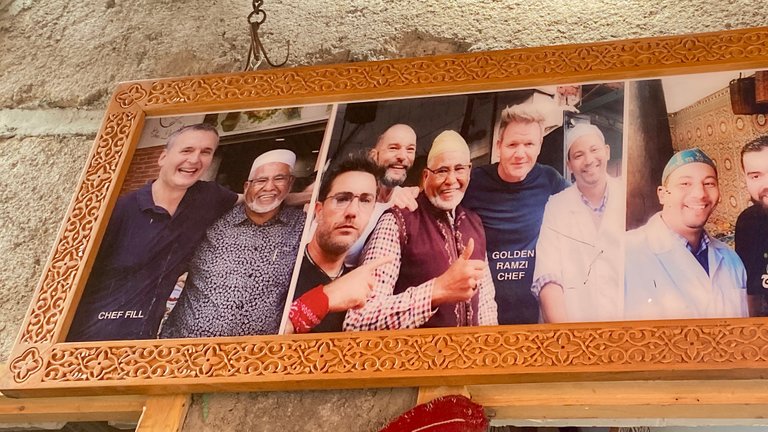 | 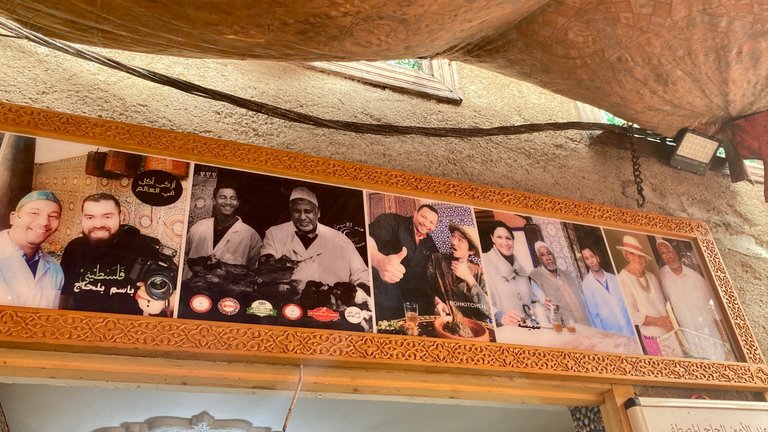 |
|---|
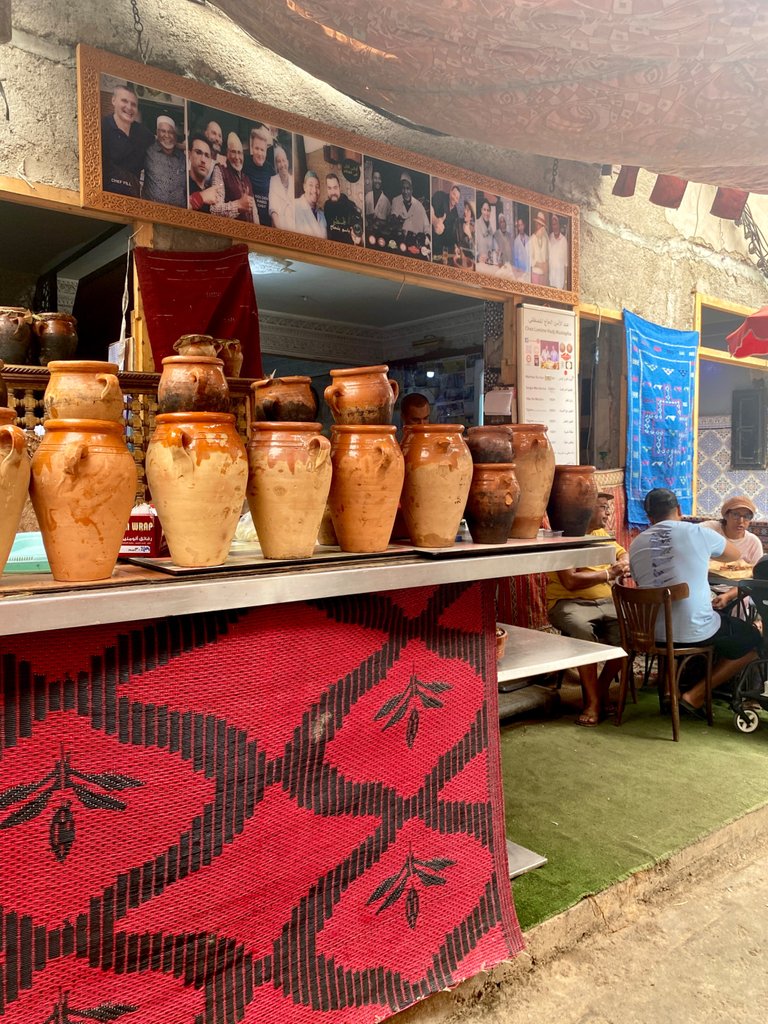 | 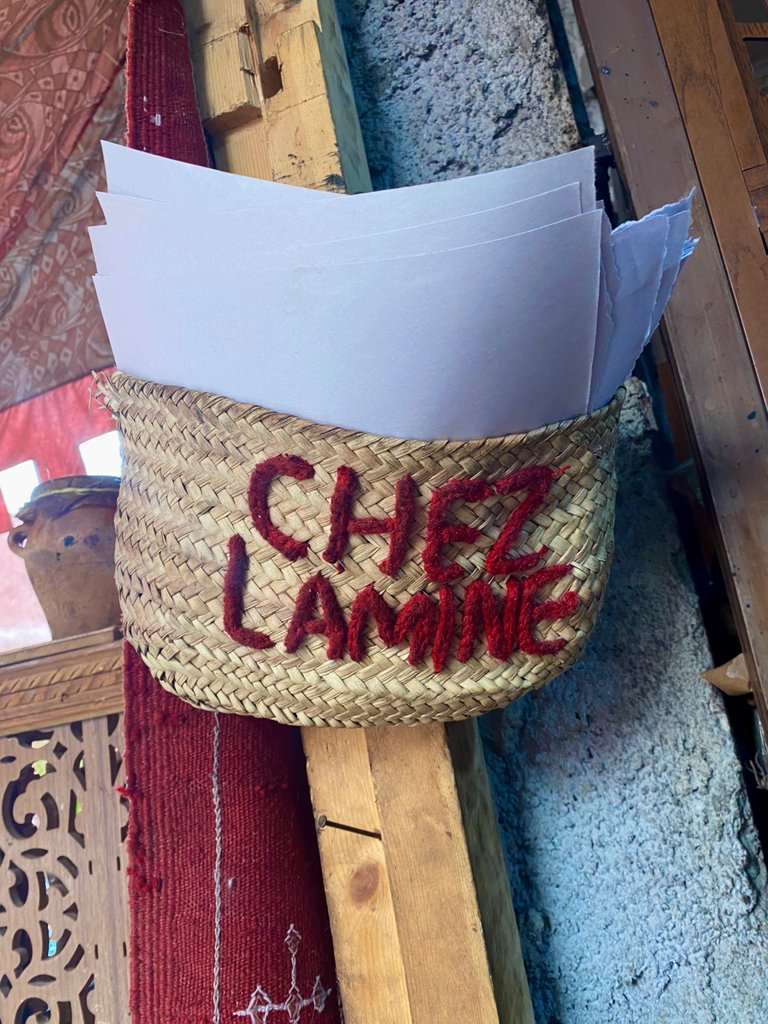 | 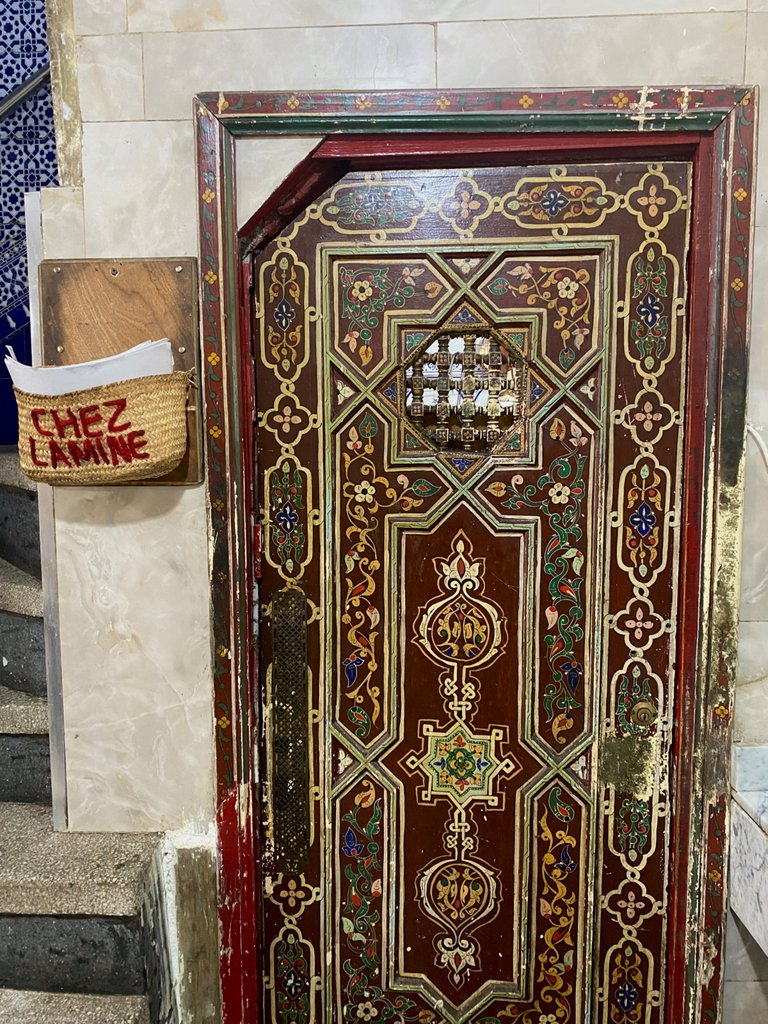 |
|---|
Walking in through the pile of earthenware pots and exposed roasted lamb heads, we found a small place with about 6 small tables arranged in front of a kitchen where dishes come out continuously and non-stop.
At the back there are stairs that lead to the four upper floors where we were directed by a waiter, he placed us if I am not mistaken in the third floor, which had large windows that kept the atmosphere fresh and offered us views of the roofs of the city.
At the time we arrived, it was 14:00, there was only one table occupied on the third floor of the restaurant, although shortly after, it began to fill up as well. They are open all day, although the recommendation if you want to try the famous roast lamb is to go at noon, because due to the elaboration process when the portions prepared during the morning are finished, they do not prepare more until the next day.
Entrando a través del montón de jarrones de barro y cabezas asadas de cordero expuestas, nos encontramos con un pequeño local de unas 6 mesas pequeñas dispuestas en frente de una cocina de donde salen platos continuamente y sin parar.
Al fondo se encuentran unas escaleras que llevan a las cuatro plantas superiores por las que nos dirigió un camarero, nos ubico si no me equivoco en la tercera, que contaba con grandes ventanas que mantenían el ambiente fresco y nos ofrecía vistas hacia los techos de la ciudad.
En el momento en el que llegamos, eran las 14:00, solo había una mesa ocupada en la tercera planta del restaurante, aunque poco después comenzó a llenarse esta también. Atienden en horario continuo, aunque la recomendación si se quiere probar el famoso cordero asado es ir al medio día, porque debido al proceso de elaboración cuando se acaban las porciones elaboradas durante la mañana no preparan más hasta el día siguiente.
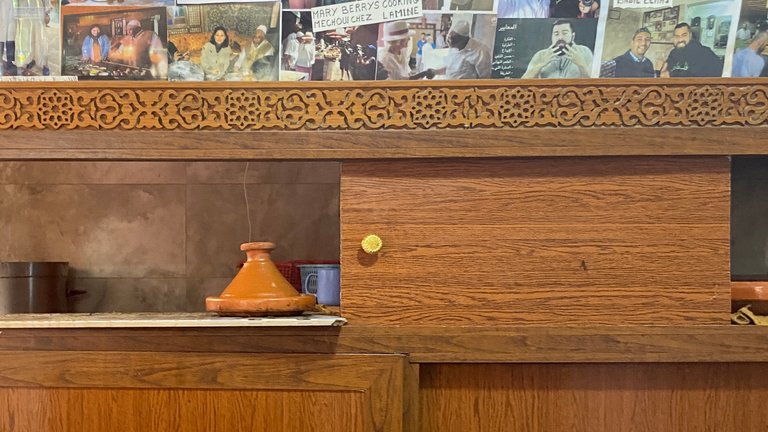
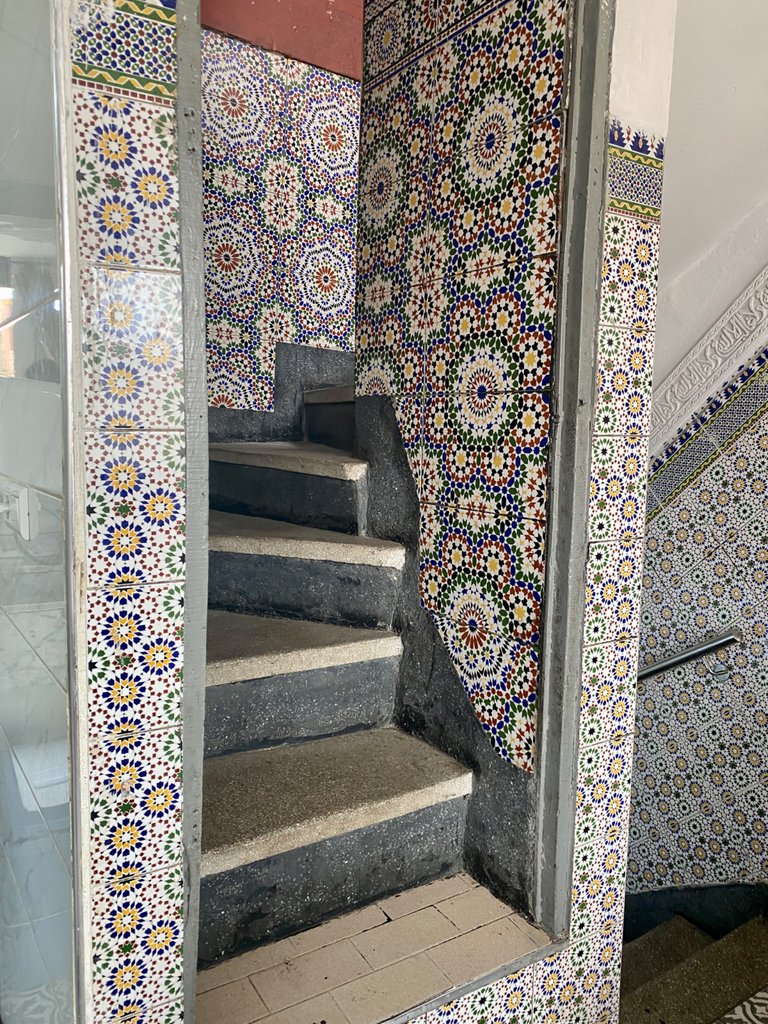 | 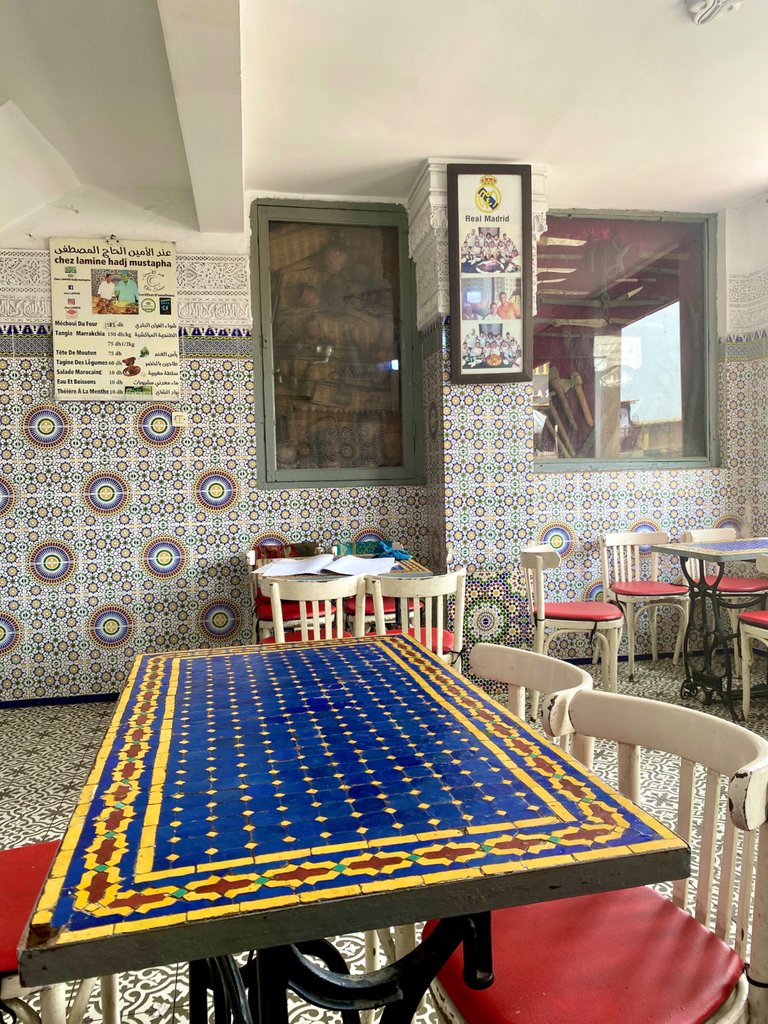 | 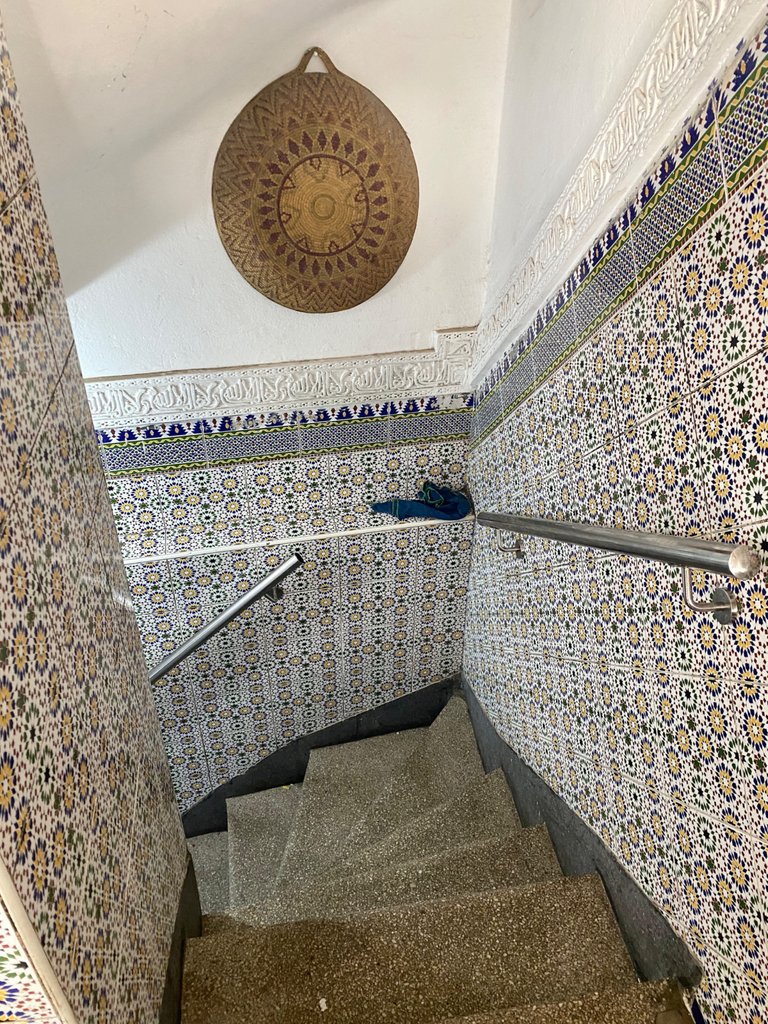 |
|---|
Each floor is decorated with various posters remembering the famous visits by celebrities, there are many and although I do not know most of them, on our floor there was a frame with several photographs of Real Madrid CF enjoying a whole lamb and a gigantic couscous.
It should be noted that I loved the decoration of the tiles, at first it may seem overwhelming so much ornament on the walls, but then to appreciate the detail and the harmony of colors is even comforting.
There is also a concise menu on the wall, where the price of each dish is displayed in both Arabic and French, although the waiters served us in English without any problems. The prices are very affordable, if we round up a little the kilo of roast lamb would be around 18,00 € and an individual dish such as the vegetable Tajin 6,00 €.
The first three dishes on the menu were my goal on this visit, they are very typical dishes in the city and that caused me some distrust to try in places a little more exposed, basically for hygiene reasons, so being in a place with such good references I decided to take advantage.
Cada planta está decorada con diversos carteles que rememoran las insignes visitas por parte de celebridades, son muchas y aunque no conozca a la mayoría en nuestra planta estaba dispuesto un cuadro con varias fotografías del Real Madrid CF disfrutando de un cordero entero y un cuscús de gigantescas dimensiones.
Cabe destacar que la decoración de los azulejos me encantó, al principio puede parecer abrumador tanto adorno en las paredes, pero luego al apreciar el detalle y la armonía de los colores resulta hasta reconfortante.
Está dispuesto en la pared también el conciso menú en el que se expone, tanto en árabe como francés, el precio de cada elaboración aunque los camareros nos atendieron en inglés sin problemas. Son precios muy accesibles, si redondeamos un poco el kilo del cordero horneado valdría alrededor de los 18,00 € y un plato individual como el Tajín vegetal 6,00 €.
Los primeros tres platos del menú eran mi objetivo en esta visita, se trata de platos muy típicos en la ciudad y que me causaba cierta desconfianza probar en lugares un poco más expuestos, por cuestión de higiene básicamente, así que estando en un sitio con tan buenas referencias decidí aprovechar.
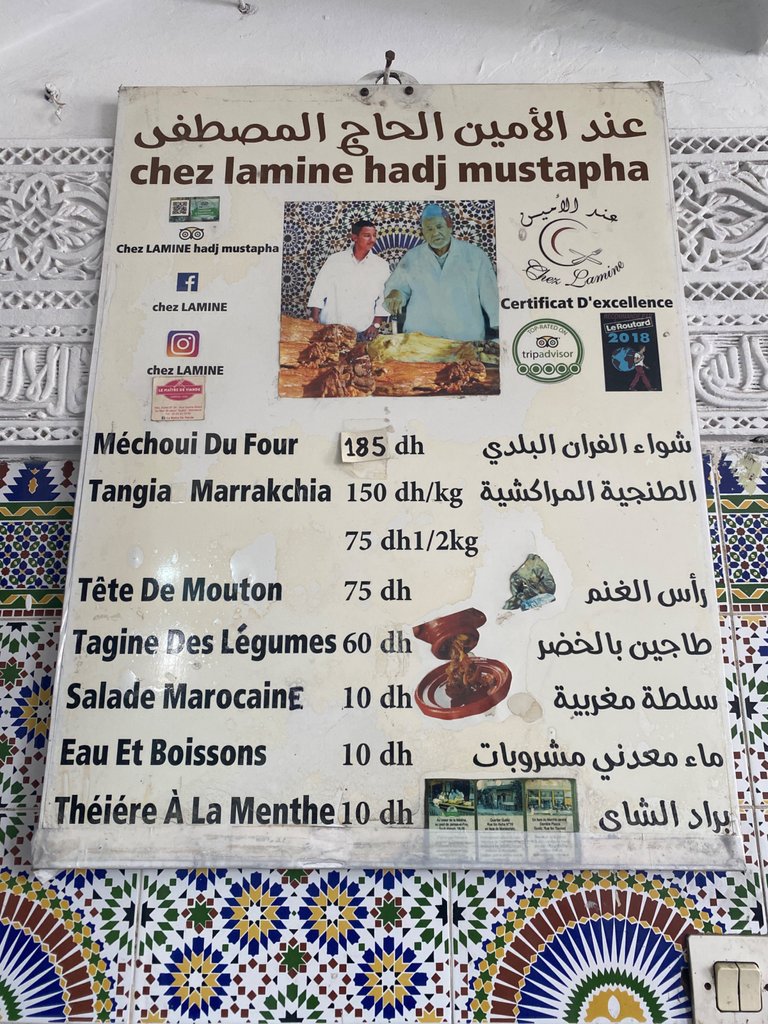 | 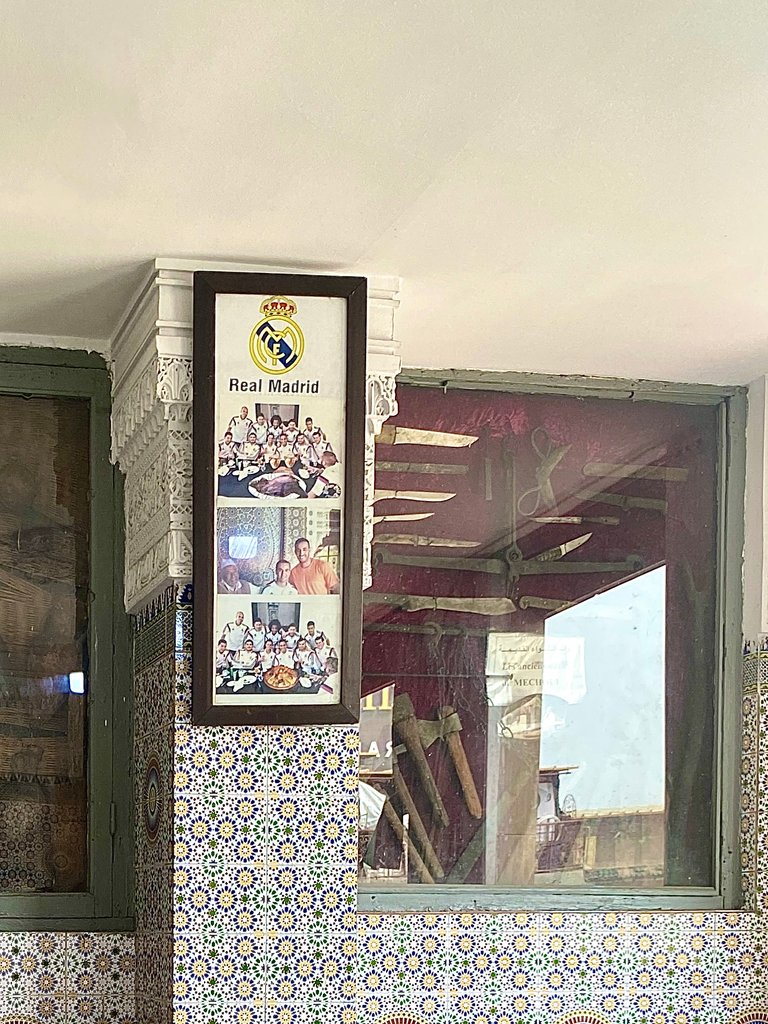 |
|---|
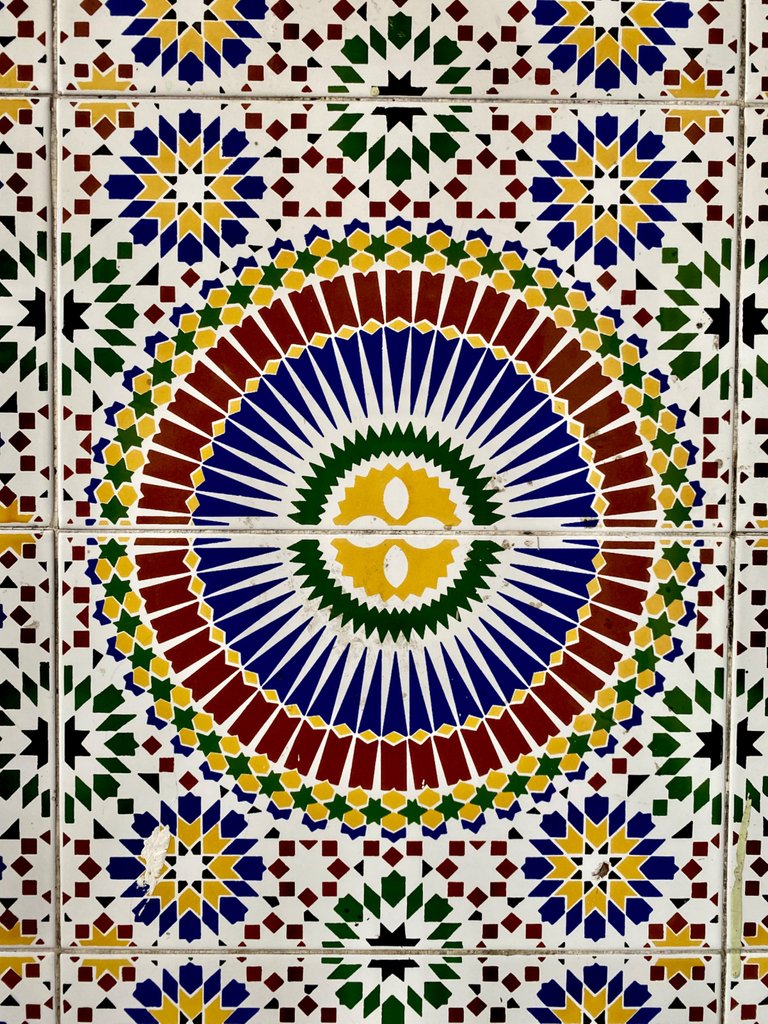
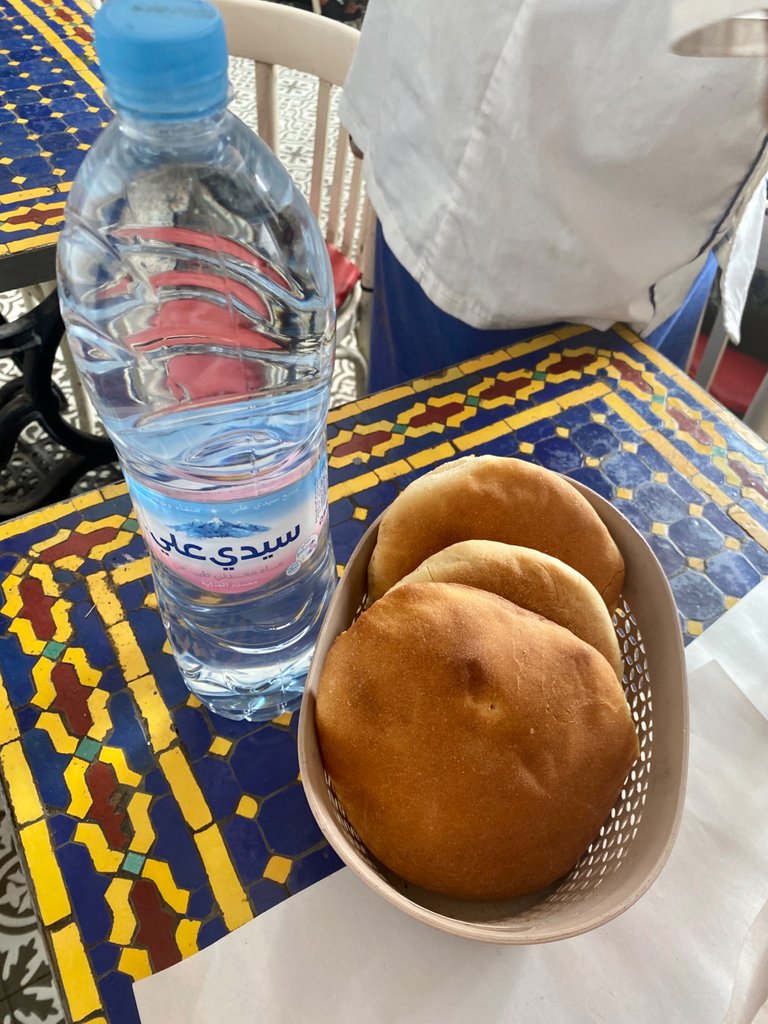
We told the waiter about our preferences and especially listened to his recommendations regarding quantities, I was very enthusiastic and wanted to try everything, but we were only two people and I could not exceed.
We decided to order only the main courses without side dishes, because they always provide bread with any dish and the option available was basically a raw salad, very typical also but we still didn't feel very confident in eating uncooked food that could be bad for us, the issue of water used in Morocco is somewhat delicate.
So it is advisable to always ask for bottled water, and if you ask for fruit juices make sure that these are prepared only with fruit or bottled water. Also the preferred drink to accompany meals in Marrakech is mint tea, but with the heat we didn't consider this option at the beginning.
I have to make a special mention to the round bread that we were served everywhere, it is called Khobz. It is wheat flour based with a soft crust, a very fluffy crumb and a slight sweet taste. Delicious. Something as simple as bread, that is well made and as nice as these is enough as an accompanying carbohydrate in many meals in the country.
The khobz is used in the form of "cutlery", since these are not frequent in the meals and almost everything is eaten with the hands using this bread as a spoon. It is not so complicated although it is rare and therefore cutlery is usually available for tourists.
Comentamos con el camarero que nos atendía nuestras preferencias y sobre todo sus recomendaciones en cuanto a cantidades, yo estaba muy entusiasmada y tenía ganas de probar de todo, pero éramos solo dos personas y no podía exagerar.
Decidimos pedir solo los platos principales sin acompañantes, debido a que siempre te proveen pan con cualquier plato y a que la opción disponible era básicamente una ensalada cruda, muy típica también pero que aun no nos sentimos muy seguros en ingerir alimentos sin cocción que pudieran sentarnos mal, el detalle del agua empleada en Marruecos es delicado.
Por lo que es recomendable siempre pedir agua potable, y si se piden zumos de frutas asegurarse que estos son preparados solo con la fruta o con agua envasada. Además la bebida por excelencia para acompañar las comidas en Marrakech es el té de menta, pero con el calor que hacía no consideramos está opción al principio.
Tengo que hacer una mención especial al pan redondo que nos servían en todos lados, se llama Khobz. Es a base de harina de trigo con una corteza suave, una miga muy esponjosa y un ligero sabor dulce. Delicioso. Algo tan simple como el pan, que esté bien hecho y sea tan agradable como estos es suficiente como carbohidrato de acompañamiento en muchas comidas del país.
El khobz es utilizado en forma de “cubiertos”, pues estos no son frecuentes en las comidas y casi todo se comer con las manos empleando este pan como cuchara. No es tan complicado aunque se hace raro y por eso suele haber cubiertos disponibles para los turistas.
 |  |
|---|
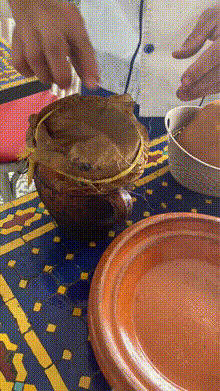
We had a very short wait for our food after ordering. It took a little longer for our order to be taken, I imagine that going up and down all those stairs at every moment had something to do with it.
While we waited I looked cautiously at the diners at the table before us, who already had their food, wondering if the amount of food we finally decided on had been right and if it was not too little.
The three dishes we chose could be ordered by weight or by half or full portions. This made me think that a kilo for example would be a lot, but looking at the other table and the sizes of their containers I could not guess if they, being several people, had ordered various small portions or if the big portions were not so big.
With those thoughts in mind we were discussing our final decision when the waiters indicated that they would prepare the table to begin serving us. Once the food started to arrive, it was non-stop. So we had the entire table laid out with our entire order. Each time they brought a dish they surprised us with the presentation and the look of some of it.
So let's detail a little more each of these emblematic dishes of the city of Marrakech.
But of course, we need to be a little open-minded. xD
Estuvimos muy poco tiempo esperando nuestra comida después de ordenar. Costó un poco más de tiempo que nos tomaran la orden, me imagino que lo de subir y bajar todas esas escalares a cada momento tiene algo que ver.
Mientras esperábamos miraba con prudencia a los comensales de la mesa que estaban en el local antes que nosotros, que disponía ya de su comida, pensando si había sido acertada la cantidad de comida por la que finalmente decidimos y si no sería más bien poco.
Los tres platos que elegimos se podían pedir por peso o por medias raciones o raciones completas. Esto me hacía pensar que un kilo por ejemplo sería mucha cantidad, pero viendo a la otra mesa y los tamaños de sus recipientes no lograba adivinar si ellos, siendo varias personas, habían pedido varias racione pequeñas o si es que las porciones grandes no lo eran tanto.
Con esos pensamientos en mente comentábamos nuestra decisión final cuando nos indicaron que harían algo de espacio en la mesa para comenzar a servirnos. Una vez que comenzó a llegar la comida, fue un no parar. Así que tuvimos toda la mesa dispuesta con toda nuestra orden. Cada vez que traían un plato nos sorprendían con la presentación y el aspecto de alguna.
Por lo que vamos a detallar un poco más cada uno de estos emblemáticos platos de la ciudad de Marrakech.
Pero eso sí, hay que tener un poco de mente abierta. xD
Tangia Marrakchia
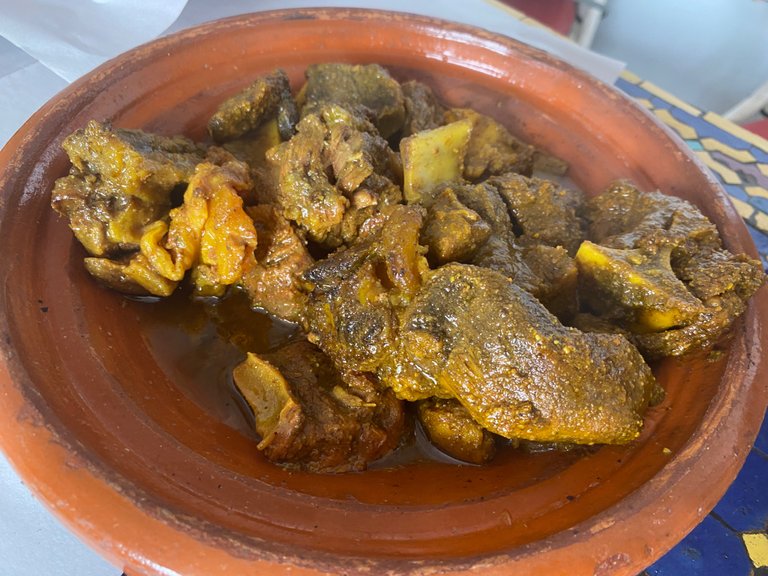
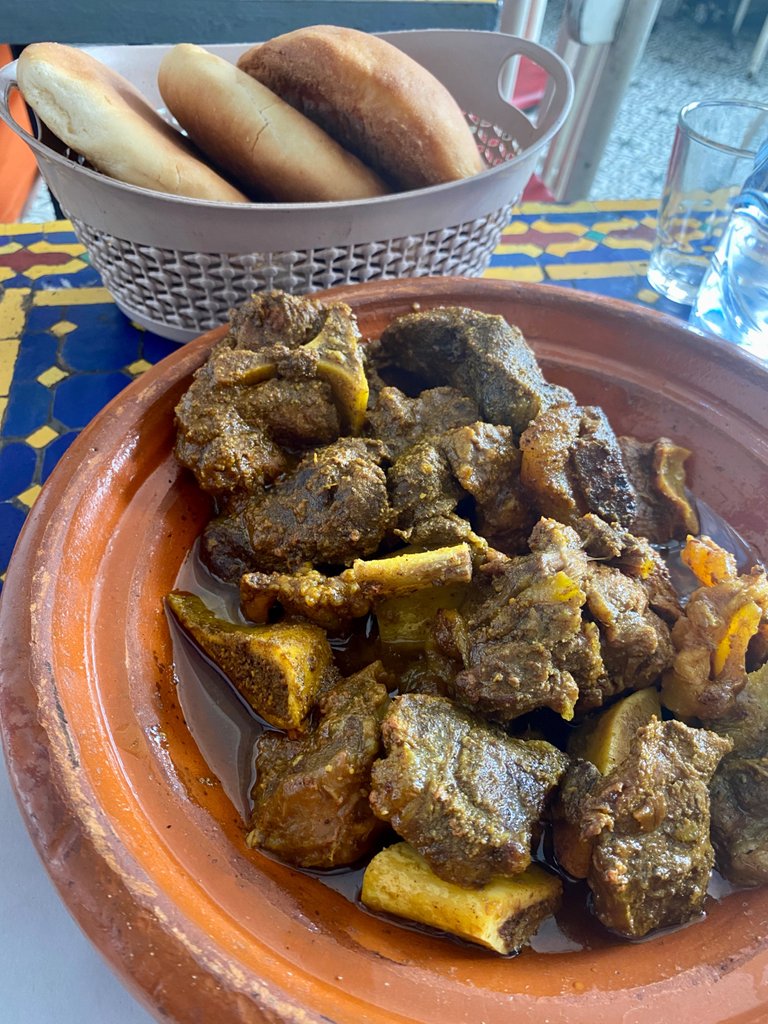 | 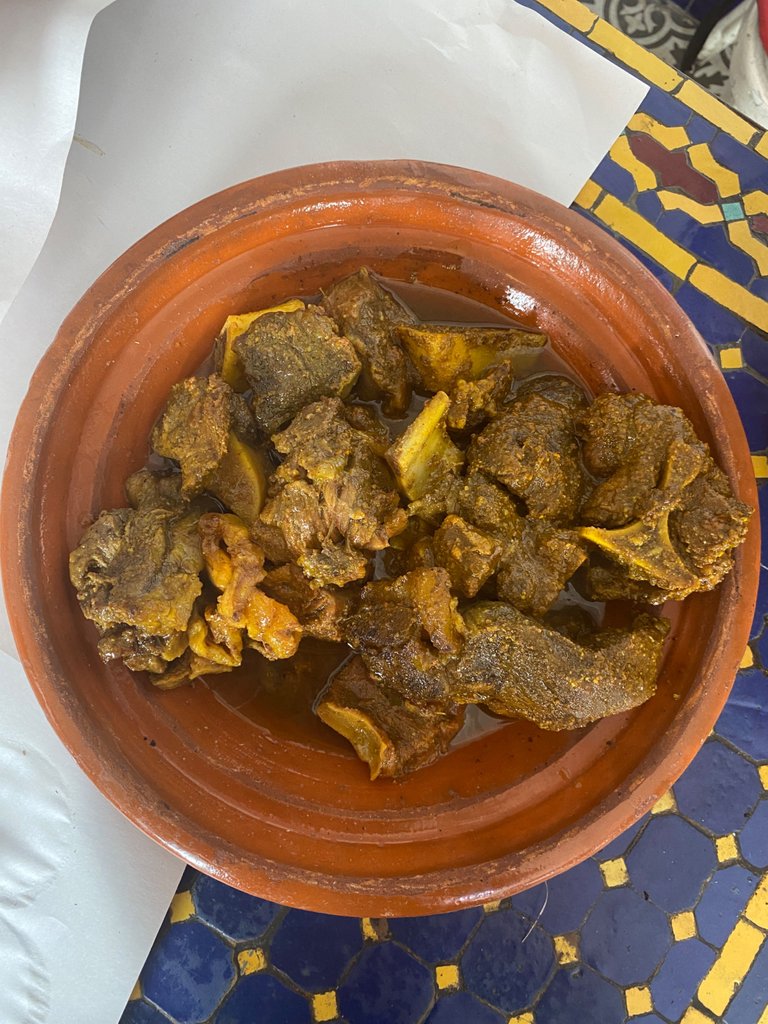 | 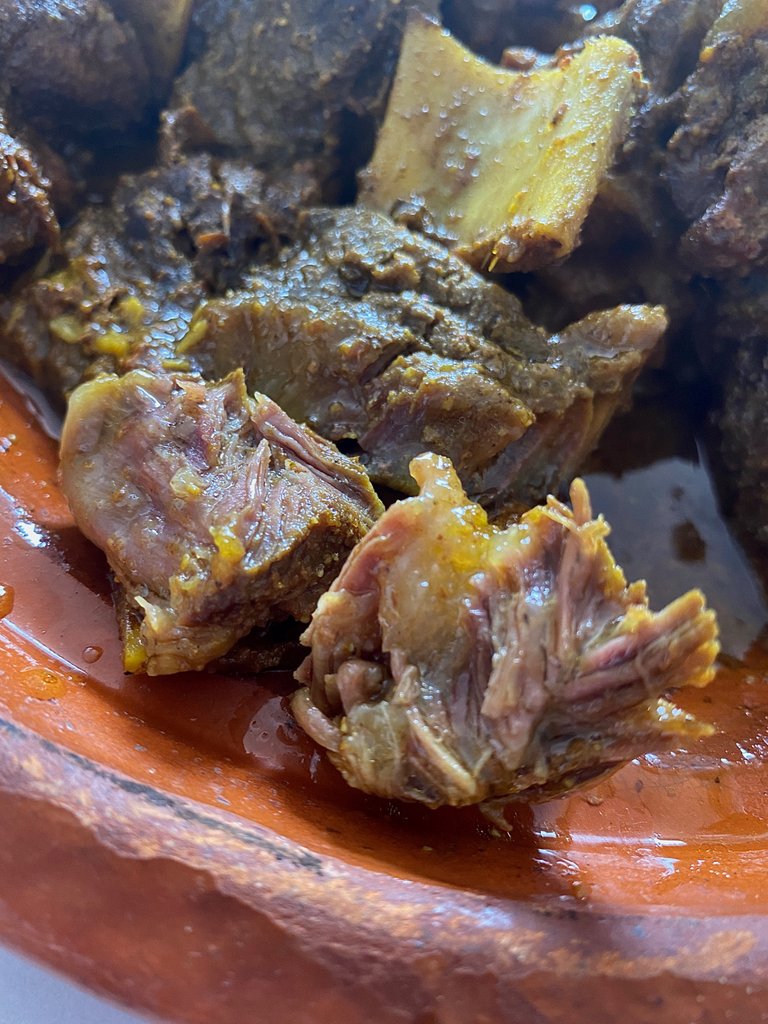 |
|---|
Marrakech on a plate. Lamb baked slowly for 8 hours in a clay pot and in the ashes of a huge oven. This brings out the flavors of this dish is the mix of spices that are added and particularly the delicious addition of the pickled lemon with which it is cooked.
For me it was the first time I tasted pickled lemon and in the dish, once prepared, you really do not perceive the intensity that characterizes the lemon after having gone through this fermentation process. On the contrary, both the aroma and the taste it adds to the meat are very subtle and pleasant.
Contrary to what I had previously tasted in the city, it is not a sweet or spicy dish, but a full-bodied stew loaded with the flavor of the lamb meat. Meat that by the way is extremely tender and very easy to separate from just the piece of bread that is usually used as a fork.
The waiter proceeds to serve the ordered portion at the table directly from the earthenware vase. In addition to the pieces of meat, some remaining portions of the pickled lemon can be appreciated, which melts almost completely during the cooking process and whose skin can be eaten without major inconvenience since it is soaked in the cooking broth.
As for the broth that accompanies the meat, it is important to point out how tasty it is; much of the bread we were provided was used to taste the resulting sauce. It was not full of fat nor was it heavy.
In this case we ordered the whole portion of the Tangia Marrakchia, it was a dish I had read a lot about and wanted to enjoy without rationing. The portion is more than acceptable considering that it is not cooked with vegetables like the tajín and its content is purely protein.
It was a wise decision because it took all the credit for the meal and was the one that left the best taste in our mouths. In my opinion the dish to order without a doubt in this place.
Marrakech en un plato. Cordero horneado lentamente durante 8 horas en recipiente de barro y entre las cenizas de un enorme horno. Lo que hace resaltar los sabores de este plato es la mezcla de especias que se añaden y particularmente el delicioso aporte del limón encurtido con el que se cocina.
Para mí era la primera vez que probaba limón encurtido y en el plato, una vez preparado, realmente no se percibe la intensidad que caracteriza al limón tras haber pasado por ese proceso de fermentación. Al contrario tanto el aroma como el gusto que le añade a la carne son muy sutiles y agradables.
Al contrario de lo que había probado anteriormente en la ciudad, no es un plato dulce ni picante, sino un guiso con mucho cuerpo y cargado del sabor de la carne del cordero. Carne que por cierto es sumamente suave y muy fácil de separar de tan solo con el trozo de pan que se suele utilizar de cubierto.
El camarero procede a servir en la mesa directamente del jarrón de barro la porción ordenada, pueden apreciarse además de los trozos de carne algunas porciones restantes del limón encurtido que se deshace casi en su totalidad durante la cocción y cuya piel puede comerse sin mayor inconveniente pues está embebida del caldo de coció.
En cuanto a ese caldo que acompaña la carne, es importante resaltar lo gustoso que está, mucho del pan que nos proporcionaron fue utilizado para degustar esa especie de salsa resultante. No estaba cargado de grasa ni resultaba pesado.
En este caso pedimos la porción entera de la Tangia Marrakchia, se trataba de un plato del cual había leído mucho y que quería disfrutar sin racionamientos. La porción es más que aceptable teniendo en cuenta que no se cocina con verduras como el tajín y su contenido es puramente proteico.
Fue una decisión acertada porque se llevó todo el mérito de la comida y fue el que mejor sabor de boca nos dejó. En mi opinión el plato que hay que pedir sin lugar a dudas en este local.
Méchoui Du Four
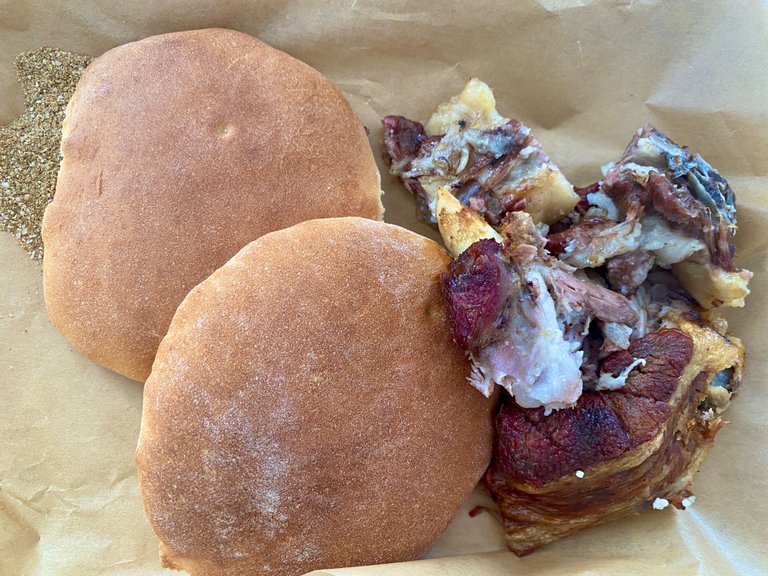
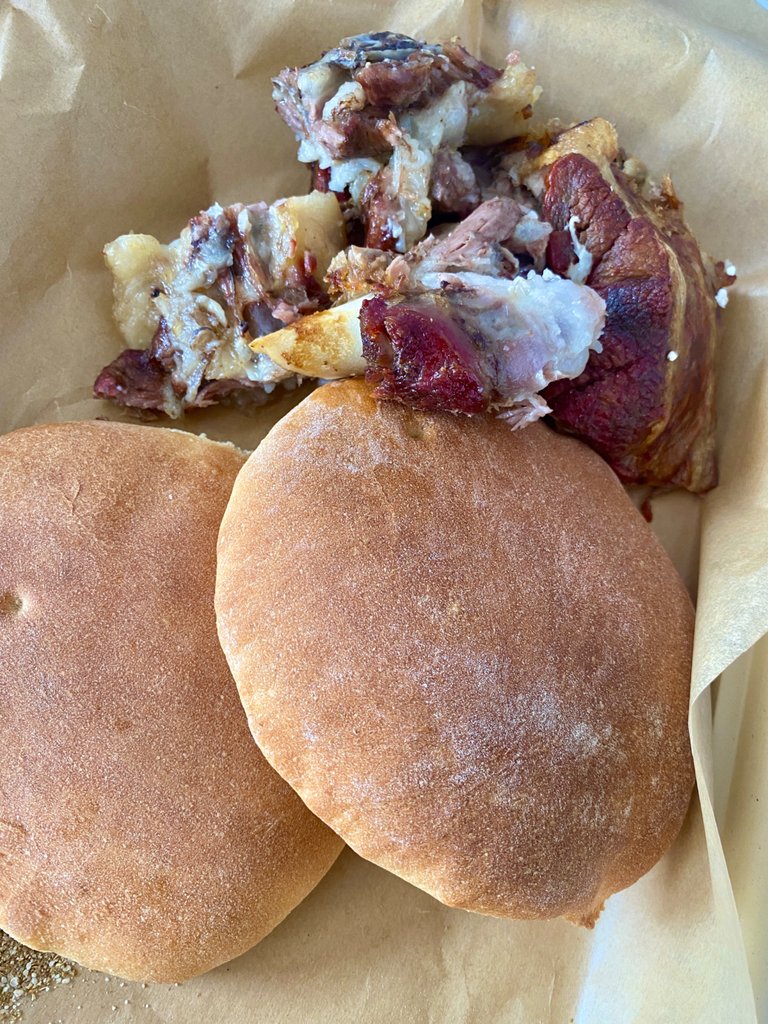 | 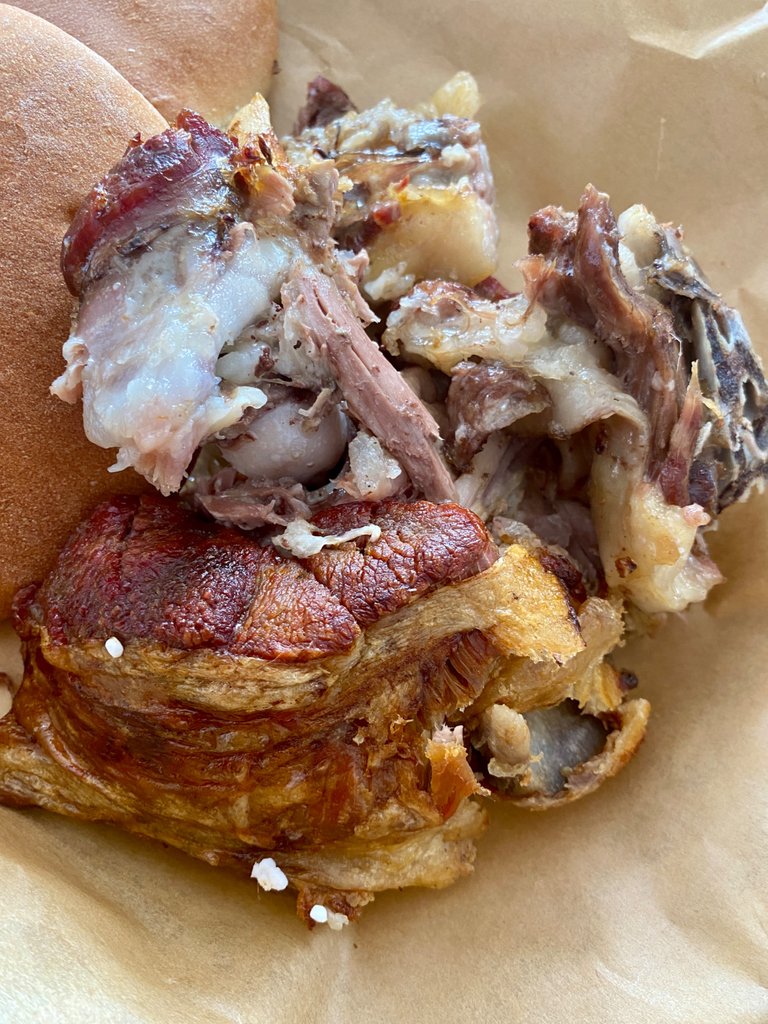 | 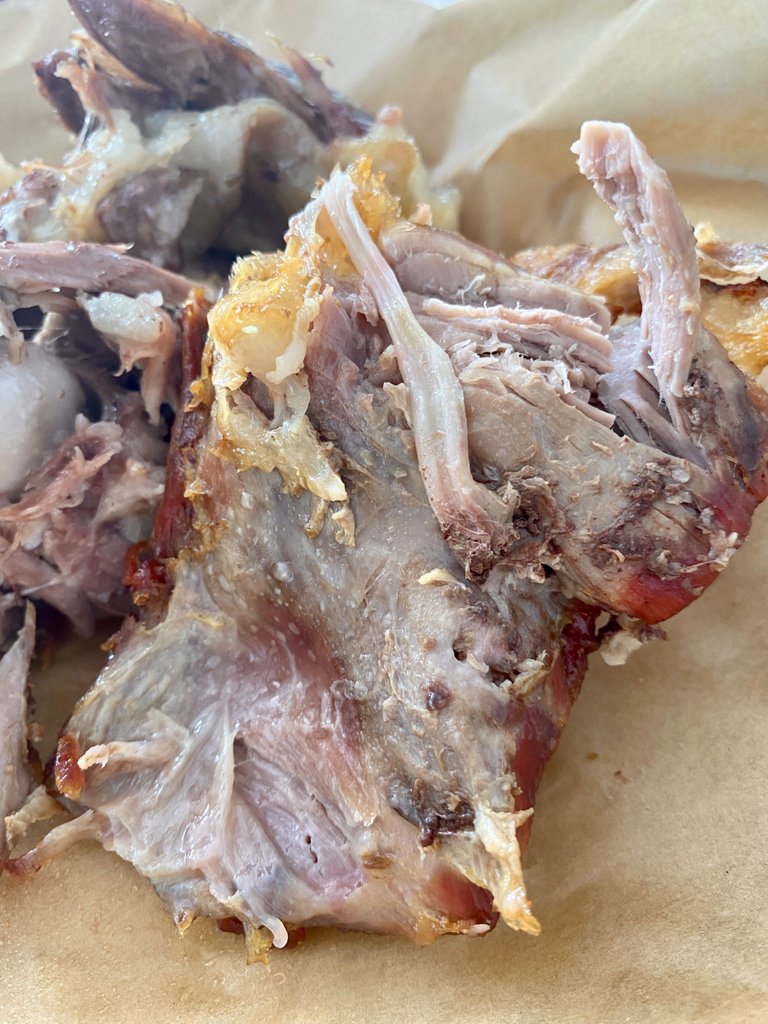 |
|---|
If the previous one was the emblematic dish of the city, this one is the emblematic dish of the Restaurant.
The Méchoui is the name given to the famous preparation of lamb roasted in subterranean ovens, very typical of the city of Marrakech and the reason why many internationally renowned chefs come to the city to witness such a rudimentary but effective method, in order to understand the basics of Moroccan cuisine and meet the best performers of this, its inhabitants.
But among them stand out those who have run this place that we visit today, particularly for developing a final product of such good quality that the former King of Morocco King Hassan II chose them as his regular cooks to prepare the Méchoui, his favorite dish, whenever he visited the city.
This is not only said by the locals and guides when they recommend you to come to eat here, but it is backed up by dozens of reports that have been made by the media to the chef in charge of the restaurant. These articles, as we will see below, have been compiled and can be found decorating the walls of the restaurant.
To elaborate the famous Méchoui, the whole piece of lamb is cleaned without leaving any element on the outside, without seasoning it is directly threaded on metal rods that are arranged vertically around the pit used as an oven, the lid of the pit is sealed with mud leaving the whole pieces of lamb to roast slowly for 3 hours.
It results in a very tender and juicy meat with a crispy skin and without any element that would adulterate the original flavor of the lamb. It is served with salt and cumin to season to taste.
In the restaurant Chez Lamine this dish is ordered according to the desired weight and the part of the lamb that is preferred. We, in our eagerness to choose a little bit of everything and because of our hurried conversation to make ourselves understood, did not stop to think about our preferences and order a specific part of the lamb. We simply asked for half a kilo of Méchoui.
So they brought us a rather meaty piece with very little fat, which made it a bit drier than other cuts although not excessively so. Depending on how much fat is involved, the juiciness of the meat will be greater. It would have been interesting to order with this piece a part of the rib or shoulder to make a contrast.
It is important to note that since it is not seasoned before cooking, the saltiness is provided by the seasoning that is served next to the piece of meat, which is brought to us along with more bread of course, so the first bite might seem a little bland if it is not seasoned, although it allows us to appreciate the real flavor of the lamb of the land.
For this particular dish I did miss the salad which we preferred not to order at first, as it becomes a bit tedious to eat only lean meat with bread, it wasn't bad but it needed a point of freshness accompanying it. Important fact for next time.
Si el anterior era el plato emblemático de la ciudad, este que detallaremos a continuación lo es para el Restaurante.
El Méchoui es como se conoce a la famosa preparación del cordero asado en hornos subterráneos, muy típico de la ciudad de Marrakech y motivo por el que muchos cocineros reconocidos internacionalmente acuden a la ciudad para presenciar tan rudimentario pero eficaz método, para así entender las bases de la cocina marroquí y conocer a los mejores ejecutantes de esta, sus habitantes.
Pero entre ellos destacan quienes han llevado este local que visitamos hoy, particularmente por elaborar un producto final de tan buena calidad que el anterior Rey de Marruecos King Hassan II los eligió como sus cocineros fijos para preparar el Méchoui, su plato favorito, siempre que visitara la ciudad.
Esto no lo dicen solo los lugareños y guías cuando te recomiendan venir a comer aquí, sino que lo respaldan decenas de reportajes que les han hecho los medios al chef que está a cargo del restaurante. Reportajes que, como veremos mas adelante, están recopilados y se encuentran adornando las paredes del restaurante.
Para elaborar el famoso Méchoui, se limpia la pieza entera del cordero sin dejar ningún elemento por fuera, sin condimentar directamente se ensartan en varas de metal que se disponen de forma vertical al rededor de la fosa utilizada como horno, se sella la tapa de la fosa con barro dejando las piezas enteras del cordero asar lentamente durante 3 horas.
El resultado es una carne muy tierna y jugosa con una piel tostada y sin ningún elemento que adultere el sabor original del cordero. Este se sirve acompañado de sal y comino para condimentar al gusto.
En el restaurante Chez Lamine este plato se ordena según el peso deseado y la parte del cordero que se prefiera. Nosotros en el afán por elegir de todo un poco y por nuestra atropellada conversación para hacernos entender no nos detuvimos a pensar en nuestras preferencias y pedir alguna parte específica del cordero. Simplemente pedimos medio kilo de Méchoui.
Así que nos trajeron una pieza bastante carnosa y con muy poca grasa, lo que la hacía un poco mas seca que otros cortes aunque no lo estaba en exceso. Según cuanta grasa haya involucrada la jugosidad de la carne será mayor. Hubiese sido interesante pedir junto a este trozo una parte del costillar o de la paletilla para poder hacer contraste.
Es importante destacar que al no estar sazonado andes de cocinarlo, el punto de sal se lo damos con los aderezos que nos sirven al lado de la pieza de carne, que nos traen junto a más pan por supuesto, así que el primer bocado podría parecer un poco insípido si no se sazona, aunque permite apreciar el sabor real del cordero de la tierra.
Para este plato en particular sí me hizo falta la ensalada que preferimos no pedir al principio, pues se hace un poco tedioso comer solo carne magra con pan, no estaba mal pero necesitaba un punto de frescura acompañándole. Dato importante para la próxima vez.
Tète De Mouton
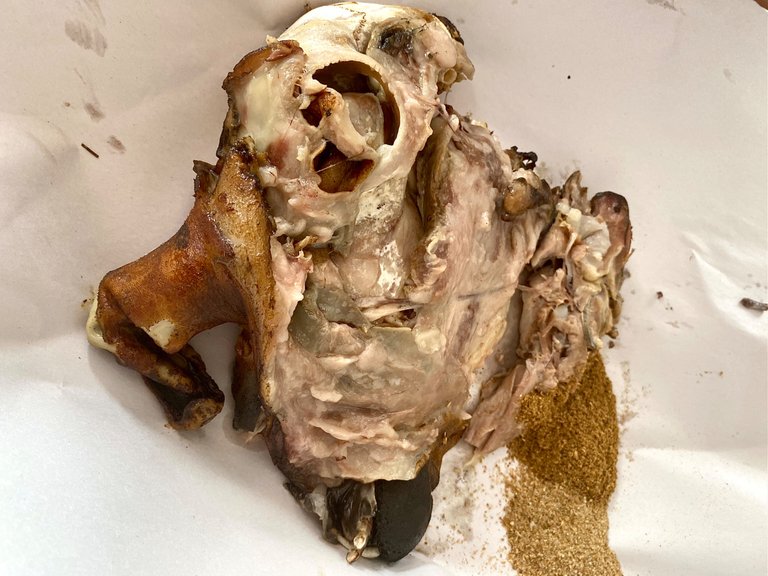
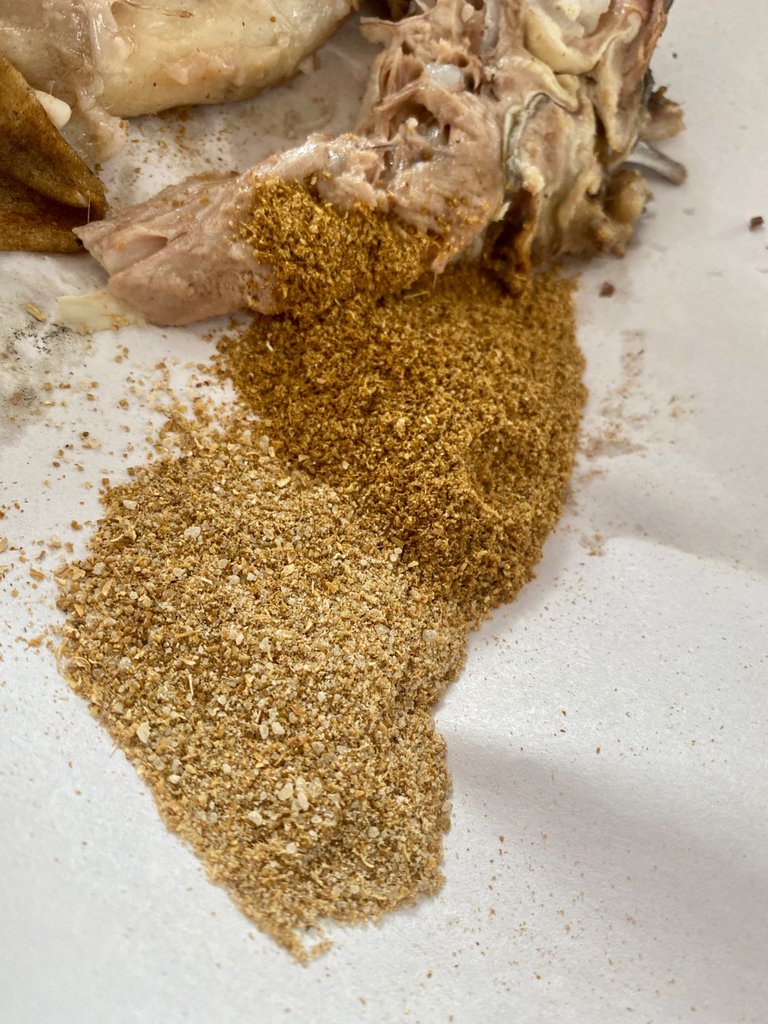 |  | 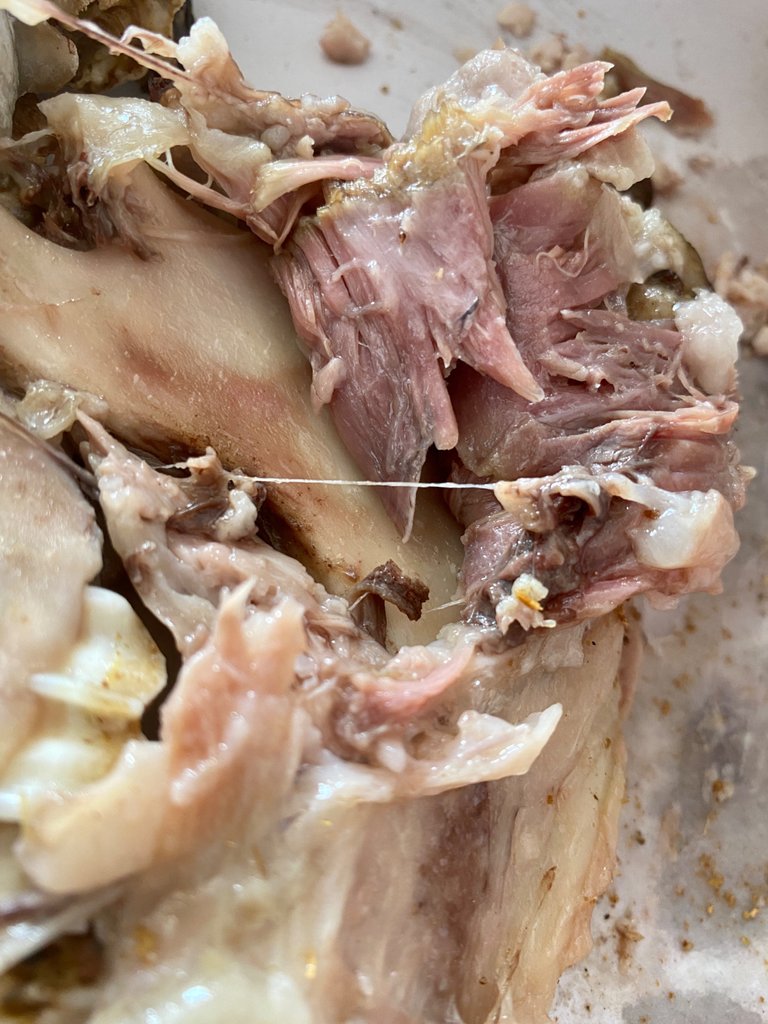 |
|---|
It is time not to start judging only by what we see and let yourself be carried away by the gastro-adventurous spirit.
In Marrakech it is very typical to eat the head of the lamb, in fact it is not such a strange practice worldwide, it just causes a kind of an impression to see the head of an animal served on a plate.
This part of the lamb is cooked in the same way, in clay pits, but separated from the rest, I have no idea why but I guess it has to do with the cooking temperature to prevent it from burning before the rest is ready, but being there I failed to deduce anything concrete about it. I was more entertained seeing what I had on the plate than thinking about how it had actually been prepared.
We ordered only half a head, they serve it with the skin and part of the elements that compose it, including the tongue of course, which is one of the most demanded parts and luckily we as diners like it too.
I know that this is a somewhat controversial and arguable issue, which I respect very much because everyone eats and dares to do what he/she wants. In my case, I am very interested in trying most of the gastronomic elements that are normal in other cultures and that we reject just for lack of knowledge. Proof of this is that during my stay I got to try some soup being that I do not like it.
The experience was curious, it is a piece with different gelatinous textures, they are not unpleasant and are full of flavor and collagen hahaha Although it is normal that many people do not like this type of very soft food. The most consistent of all was the tongue and the salt mixed with cumin they gave us for seasoning gave it a very good taste.
Of course there was some meat as well, and it came off the bone very easily, a sign of how tender it was. Although it left us with a somewhat disturbing image of the skull of the animal, quite curious, to say the least.
But I have to say about this dish, unlike the other two, we didn't leave anything behind. It was smaller in quantity as well, but it was easy to eat and there was nothing dry in it.
It was an experience I had pending and I have overcome it, it did not generate any kind of trauma and above all, which was what worried me the most, it didn't give me a stomach ache. That's why I don't regret having tried it in this restaurant instead of some street stand in the Jemaa el-Fna square where you see them every night.
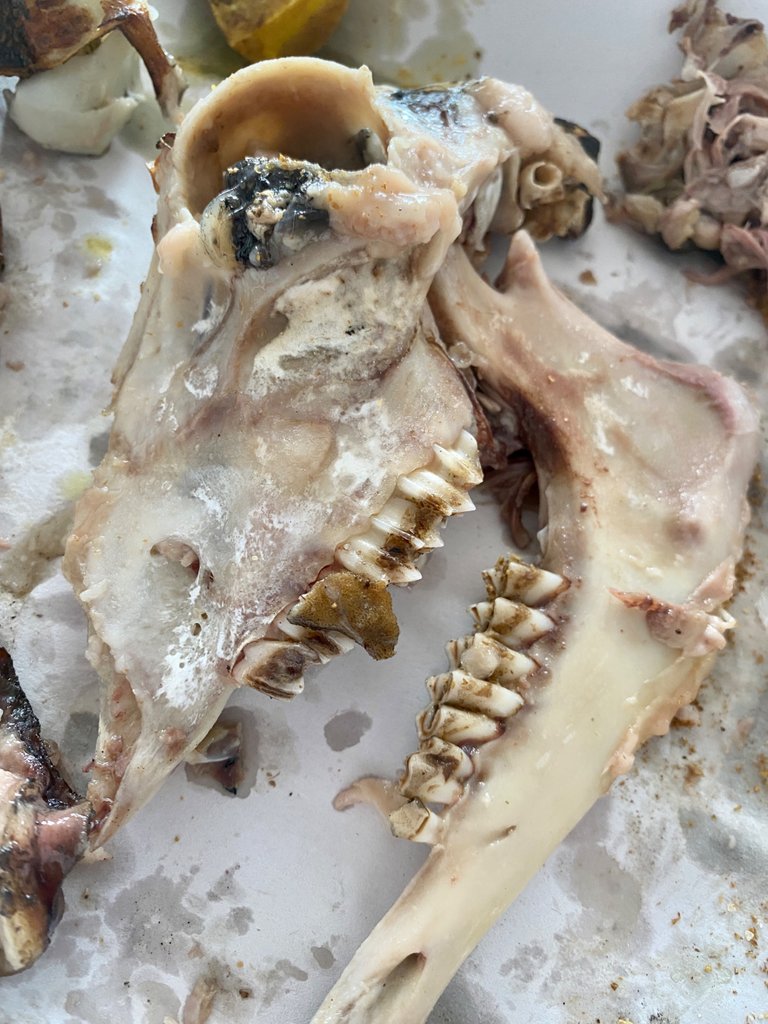
Llega el momento de no comenzar a juzgar solamente por lo que vemos y dejarse llevar por el espíritu gastro-aventurero.
En Marrakech es muy típico comer la cabeza del cordero, de hecho no es una práctica tan extraña a nivel mundial, solo que causa cierta impresión ver la cabeza de un animal servida en un plato.
Esta parte del cordero se cocina de igual forma, en fosas de barro, pero separados del resto, no tengo idea por qué pero intuyo que tendrá que ver con la temperatura de cocción para así evitar que se queme antes que el resto esté listo, pero estando allí no logré deducir nada concreto al respecto. Estaba más entretenida viendo lo que tenía en el plato que pensando en cómo había sido preparada realmente.
Nosotros pedimos solo media cabeza, la sirven con la piel y parte de los elementos que la componen, incluyendo la lengua por supuesto, que es una de las partes mas demandada y que por suerte a nosotros como comensales nos gusta también.
Ya sé que es una cuestión un tanto polémica y debatidle, cosa que respeto mucho porque cada quien come y se atreve a lo que quiere. En mi caso, siento gran interés por probar la mayoría de los elementos gastronómicos que son normales en otras culturas y que nosotros rechazamos solo por desconocimiento. Muestra de ello es que durante mi estancia llegué a probar alguna sopa siendo que no me gustan.
La experiencia fue curiosa, es una pieza con diferentes texturas gelatinosas, no son desagradables y están llenas de sabor y colágeno jajaja Aunque es normal que a mucha gente no le gusten ese tipo de comidas muy blandas. Lo más consistente de todo era la lengua y la sal mezclada con comino que nos dieron para sazonar le daban muy buen punto.
Por supuesto había algo de carne también, y esta se desprendía muy fácilmente del hueso señal de lo tierna que estaba. Aunque nos dejaba una imagen un tanto inquietante del cráneo del animal bastante curioso, por decir algo.
Pero tengo que decir de este plato, a diferencia de los otros dos, que no dejamos nada. Era menor cantidad también, pero se comía fácil y no había nada seco en él.
Era una experiencia que tenía pendiente y la he superado, no me generó ningún tipo de trauma y sobre todo, que era lo que más me preocupada, no me sentó mal en el estomago. Por eso no me arrepiento de haberlo probado en este restaurante y no en algún puesto callejero de la plaza Jemaa el-Fna en donde se ven todas las noches.
Théiére À La Menthe
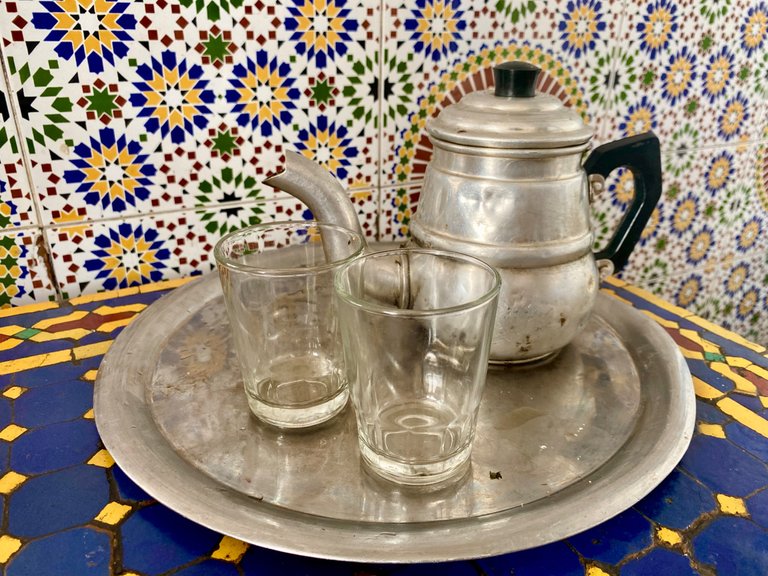
 | 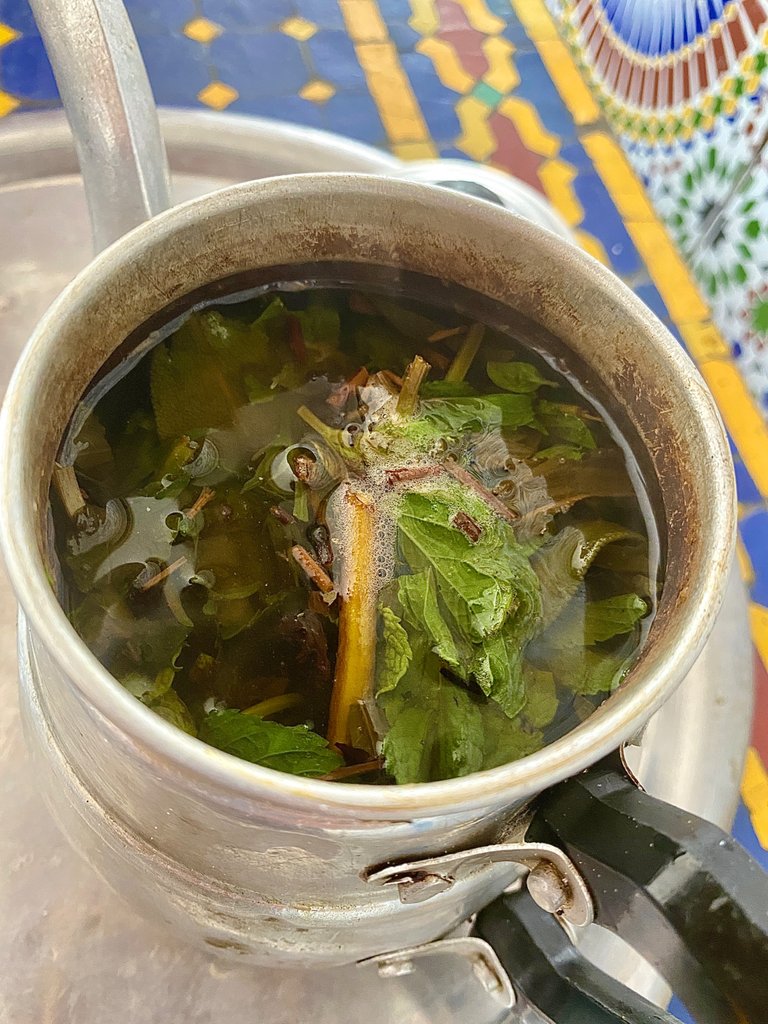 | 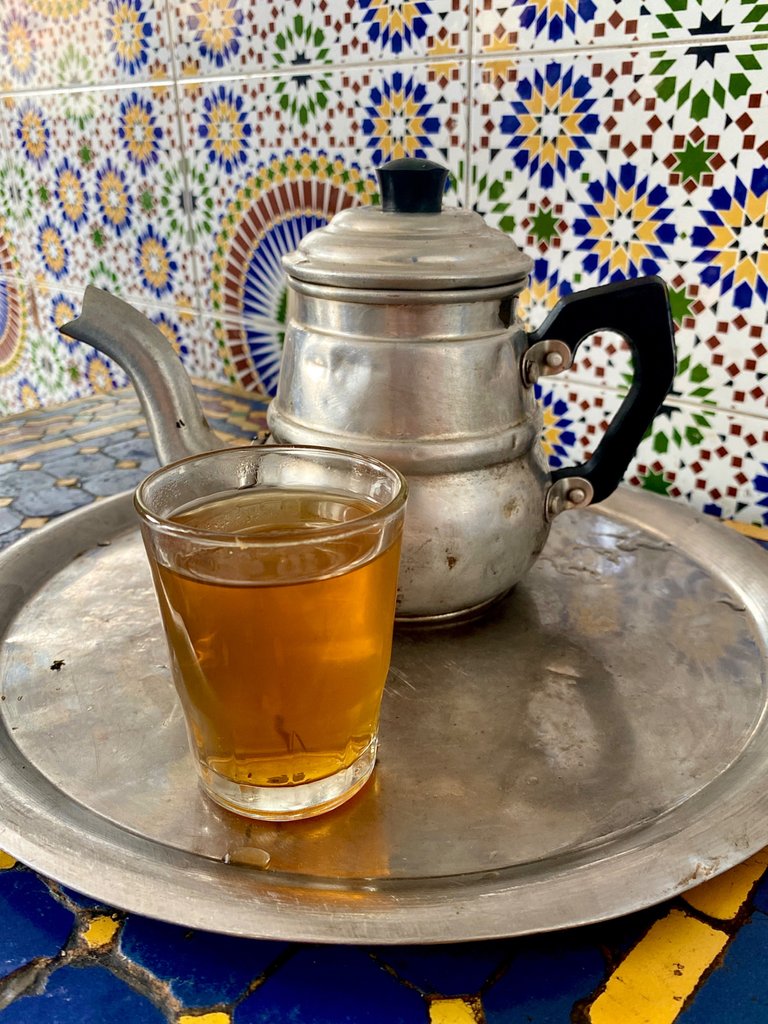 |
|---|
As a closing and in the absence of a dessert offer on the menu, we decided to end as all the tables around us were doing, by ordering a mint tea.
This drink is everywhere, not only offered at the food places but also offered by almost anyone you are talking to. There is no time, despite the scorching heat, when mint tea is not available to drink.
It can be ordered sweetened or with the sugar cubes on the side to make it to your liking. I like them unsweetened, so they brought it separately so everyone can add the sweetness they think is necessary. Otherwise they will include one or several, a lot in my opinion, of these sugar cubes in the teapot while infusing the green tea and a good amount of different mint leaves added to the water.
For only 1,00 € we enjoyed a teapot that gave us enough to refill the small glasses more than a couple of times.
The truth is that it is a good closure to the meal, it somehow makes everything ingested settle and balances the body temperature a little so that the heat is no longer so evident.
Para cerrar y a falta de una oferta de postres en la carta, decidimos terminar como lo hacían todas las mesas a nuestro alrededor, ordenando un té de menta.
Esta bebida está por doquier, no solo ofrecida en los sitios de comida sino que también ofrecido por casi cualquier persona con la que estés hablando. No hay momento, a pesar del calor abrasador, en que no haya té de menta disponible para beber.
Se puede pedir endulzado o con los terrones de azúcar a parte para hacerlo a tu gusto. A mí me gustan sin azúcar, así que lo trajeron por separado y así cada quien puede añadir el dulzor que crea necesario. De lo contrario incluirán uno o varios, mucho en mi opinión, de estos terrones de azúcar en la tetera mientras se infusiones el té verde y una buena cantidad de hojas de menta diferentes que le añaden al agua.
Tan solo por 1,00 € disfrutamos de una tetera que nos dio para rellenar los pequeños vasos más de un par de veces.
La verdad es que es un buen cierre para la comida, de alguna manera hace que se asiente todo lo ingerido y equilibra un poco la temperatura corporal para que el calor deje de ser tan evidente.
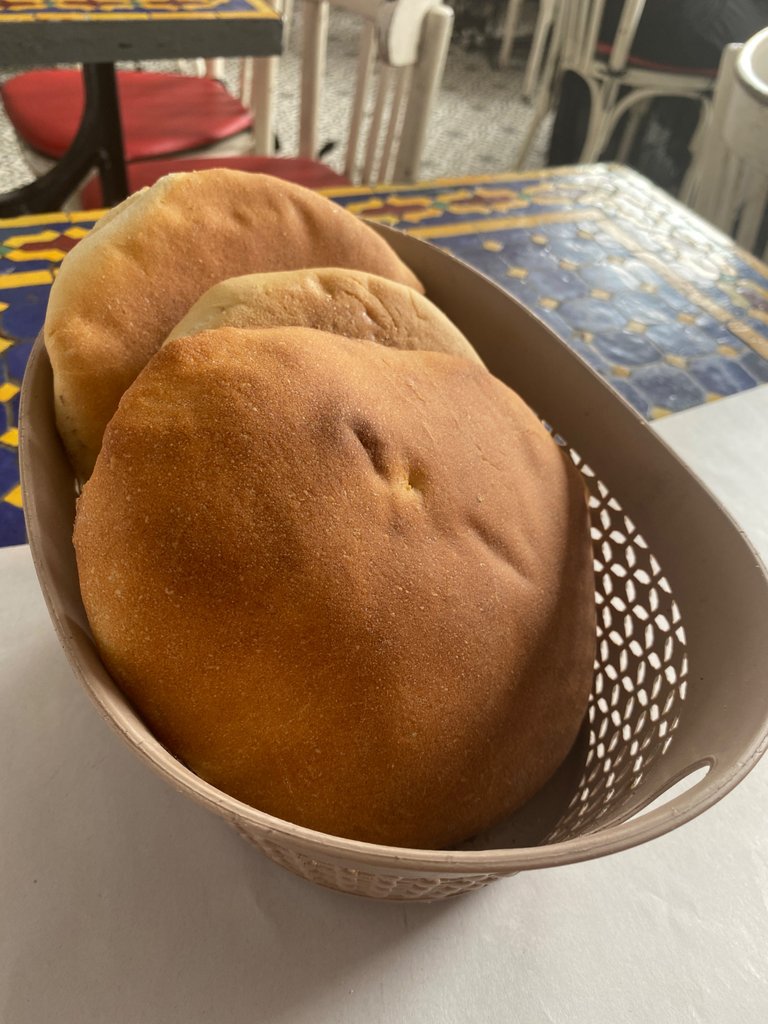
As we had quickly become firm fans of Khobz bread and it so happened that in the end the amount of food we ordered was more than enough, we decided to improvise a practice we had seen in the streets of the city.
Moroccan streetfood always has offers of this bread along with various fillings, so having the elements at hand we decided to mix the Mechoui meat we had left over with the broth and some portion of the Tangia Marrakchia.
The resulting mixture, which I don't know if it is frowned upon by the locals, was very good, and we had enough to stuff two Khobz with a good amount, guaranteeing us dinner with this meal as well.
We had time to carry out our invention and rest a bit, but after the last round no waiter had come up for a while, so we decided to go downstairs and pay on the first floor.
Como nos habíamos convertido rápidamente en fans declarados del pan Khobz y sucedió que al final la cantidad de comida que ordenamos era más que suficiente, decidimos improvisar una práctica que habíamos visto por las calles de la ciudad.
El streetfood marroquí cuenta siempre con ofertas de este pan junto a rellenos diversos, así que teniendo los elementos a la mano decidimos mezclar la carne de Mechoui que nos sobraba con el caldo y alguna porción de la Tangia Marrakchia.
La mezcla resultante, que no sé si sea mal vista por los lugareños, estaba muy buena, y nos alcanzó para rellenar con buena cantidad dos Khobz, garantizándonos con esta comida la cena también.
Tuvimos tiempo de llevar a cabo nuestra invención y descansar un poco además, pero hacía un rato que después de la ultima ronda no subía ningún camarero, así que decidimos bajar nosotros y pagar en la planta baja.
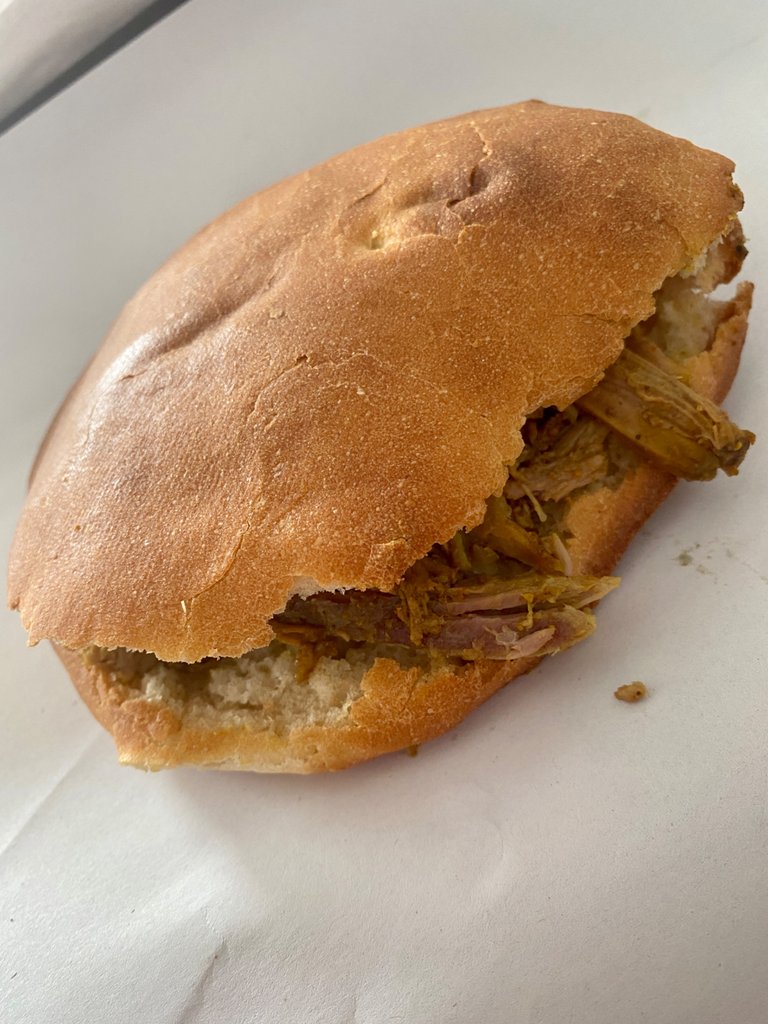 | 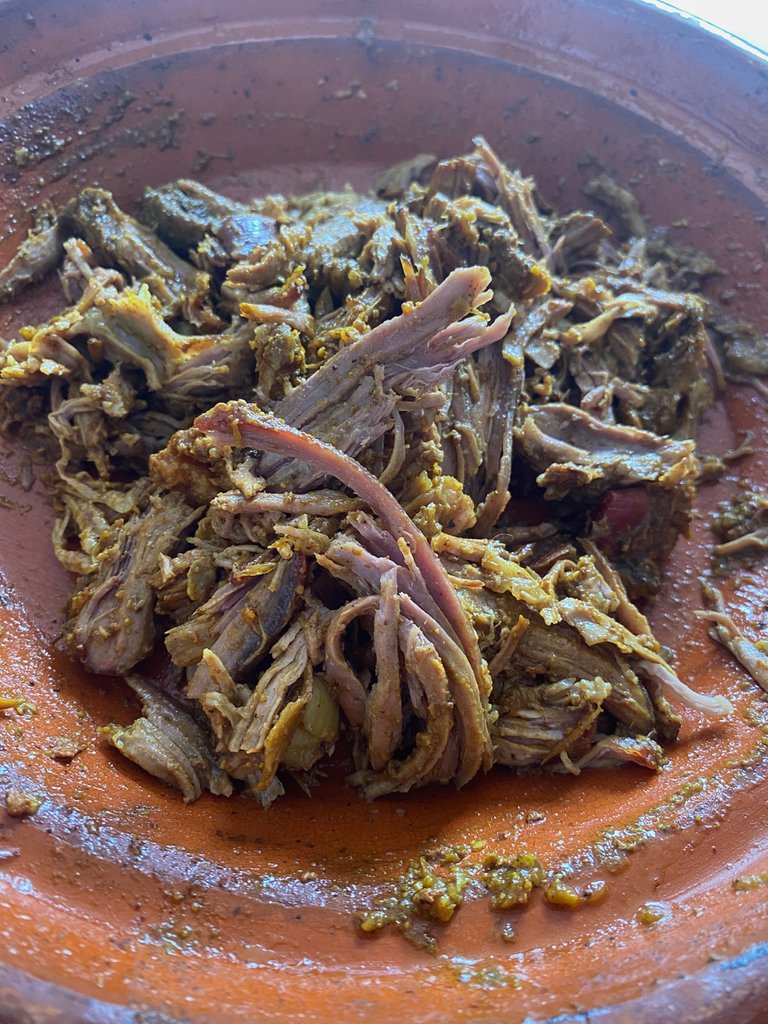 |
|---|
As we walked down through the other floors we noticed more posters with information about the history of the King's Chef, his kitchen and the many years they had been offering the quality food we had just enjoyed.
This time I was able to get a little closer and detailed several photos of Chef Ramsay* and also the famed Chef Moha who is a judge on MasterChef Morocco.
One detail I hadn't commented on is that when I went to the bathroom I noticed that they used the same paper they provide as napkins and on which they serve the food. I was amused.
Mientras bajábamos recorriendo las otras plantas observamos más carteles con información sobre la historia del Chef del Rey, su cocina y los muchos años que llevaban ofreciendo la comida de calidad que acabábamos de disfrutar.
Esta vez pude acercarme un poco más y detallé varias fotos del Chef Ramsay* y también del afamado Chef Moha que es jurado de MasterChef Marruecos.
Un detalle que no había comentado es que al ir al baño me di cuenta que utilizaban el mismo papel que proporcionan como servilletas y en el que sirven la comida. Me causó gracia.
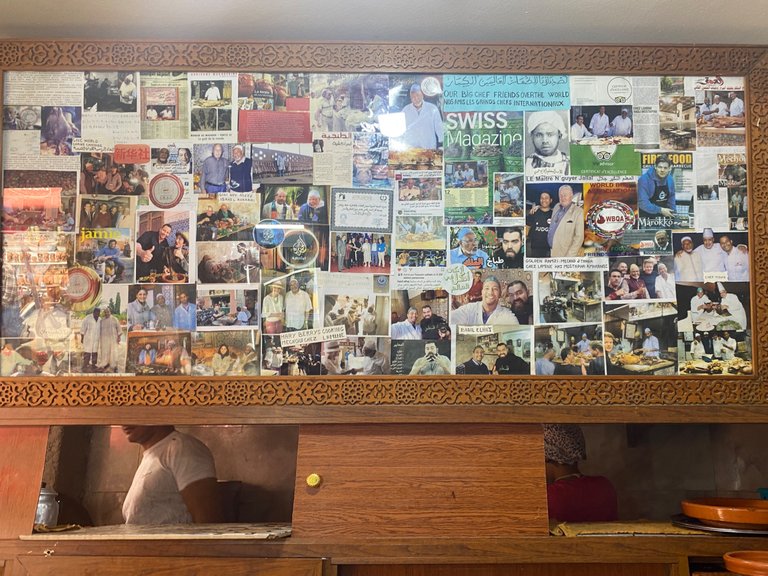 | 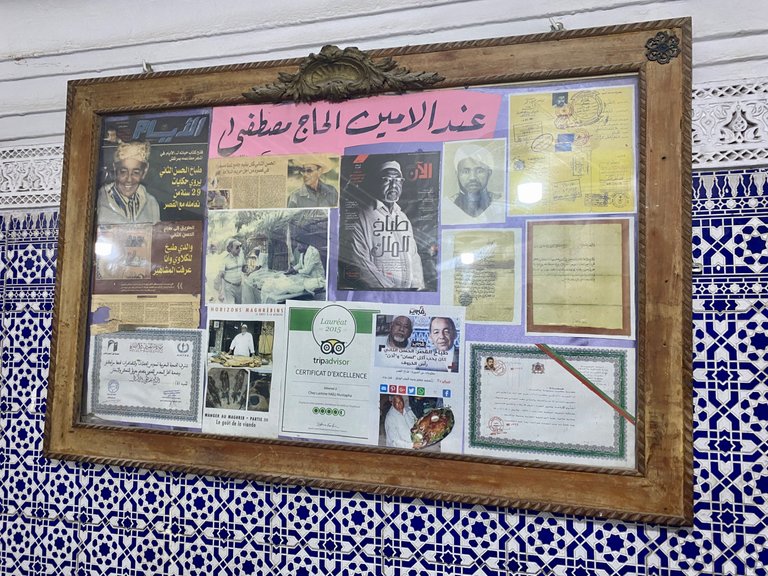 |
|---|
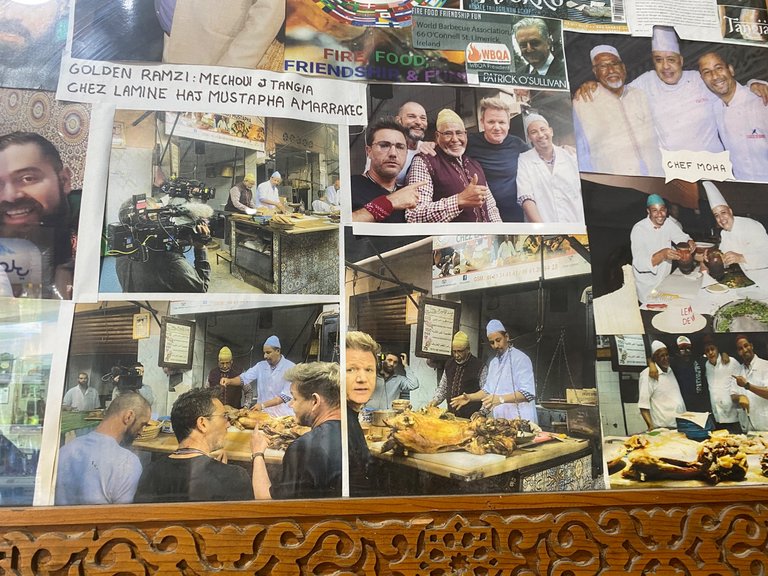

Once downstairs it was a little difficult to find someone to charge us, although later we saw that many of the waiters were again outside waiting for new diners to arrive, just as when we arrived.
As soon as he recognized us the guy who was serving us came over and began to write down on a piece of paper what we had ordered so we could see the price of each thing, he did this on his own initiative we did not ask him for it although we appreciated it, he added it up by hand as when we were in school and charged us the fair price of what we had ordered.
It was a very complete experience, we ate the must-haves of Marrakech from the King's Chef lamino and the sensations were very pleasant, as for the price, what you see on the menu in the picture is what he charges, no tricks or bargaining. A very economical price for us as tourists and more than adequate in relation to local demand.
I say goodbye with the happiness of having eaten delicious food and with the desire to continue exploring and learning more about the gastronomy of this country of such abundant flavors.
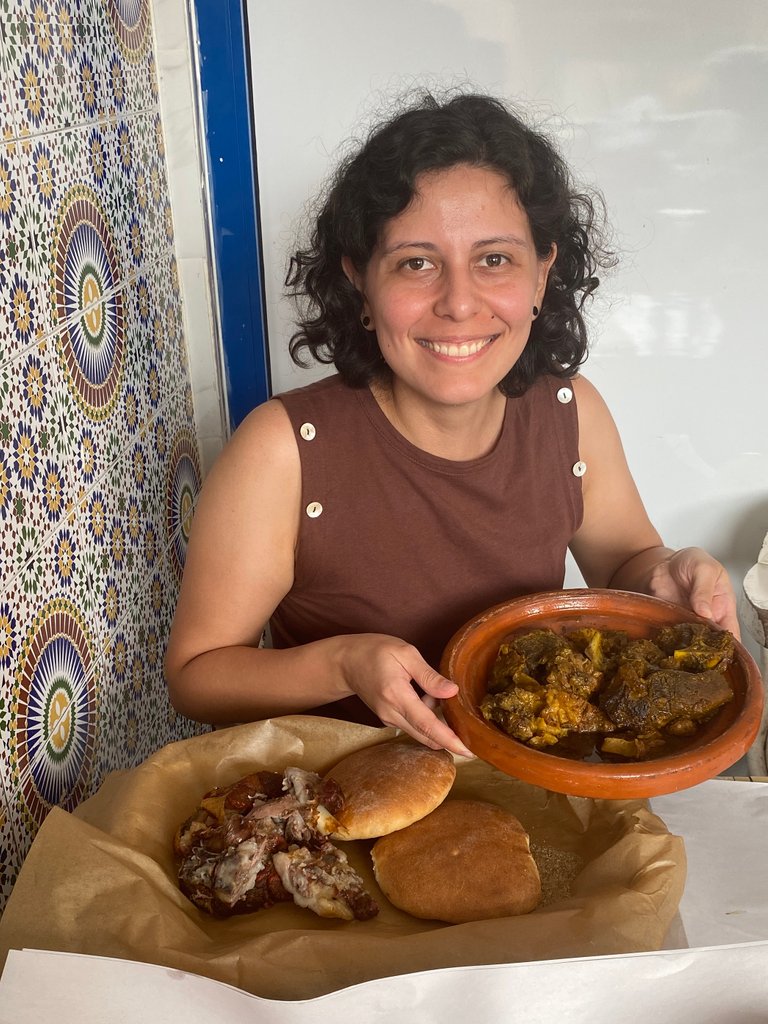
Una vez abajo nos costó un poco localizar a alguien que nos cobrara, aunque luego vimos que muchos de los camareros estaban nuevamente afuera esperando la llegada nuevos comensales tal como cuando nosotros llegamos.
En cuanto nos reconoció el chico que nos atendía se acercó y comenzó a escribir en un papel lo que habíamos ordenado para que viéramos el precio de cada cosa, esto lo hizo por iniciativa propia nosotros no se lo pedimos aunque lo agradecimos, lo sumó a mano como cuando estábamos en el colegio y nos cobró el precio justo de lo que habíamos pedido.
Fue una experiencia muy completa, comimos los imprescindibles de Marrakech de lamino del Chef del Rey y las sensaciones fueron muy gratas, en cuanto al precio, lo que se ve en el menú de la imagen es lo que cobra, sin trucos ni regateos. Un precio muy económico para nosotros como turistas y mas que adecuado con relación a la demanda local.
Me despido con la felicidad de haber comido rico y con ganas de seguir explorando y conociendo mas de la gastronomía de este país de tan abundantes sabores.
 |
|  |
| 
Free Icons: Iconfinder
Animated GIFs : Bloggif
Some of these pictures have been shared by me in other social networks.
Photo credits: All of the photos in this post were taken by me with my Iphone 11 and belong to me.
Congratulations, your post has been added to Pinmapple! 🎉🥳🍍
Did you know you have your own profile map?
And every post has their own map too!
Want to have your post on the map too?
The rewards earned on this comment will go directly to the people( @anzirpasai ) sharing the post on Twitter as long as they are registered with @poshtoken. Sign up at https://hiveposh.com.
Que interesante todo lo que nos compartes, siendo una extranjera, conoces de la gastronomía de Marruecos, aprendí mucho de tu publicación y me llamó la atención que condimentan al cordero con limón, lo cual me parece bien, así se desintoxica la carne, por ese motivo y el chef famoso me atrevería a probar estos platos muy codiciados y que por cierto son difícil de memorizar.
Tus aventuras gastronómicas son muy detalladas, cuando viaje al extranjero estaré más que preparada.
Cuando voy a lugares y veo insignias de países o grupos que también llegaron al sitio, pienso en hive. Sería increíble dejar la huella de la blockchain en lugares tan especiales como al que fuiste.🙂
Jajaja cuando viajo a cualquier lugar intento documentarme lo mejor posible, en cuanto a la gastronomía, para contrastar lo que se dice con la realidad y saber qué es eso que realmente se come en cada lugar.
No me gusta la idea de viajar y entrar a comer en McDonalds hamburguesas de 1$ solo por ahorrar, seguramente cada país tendrá su versión de la comida barata si ese fuera el caso jajajaja
Pero bueno es cuestión de gustos, yo creo que tú también disfrutas de la buena comida así que seguro lo pases bien haciendo un poquito de gastro turismo cuando viajes jejeje
Y sí el plato de Tangia que lleva ese limón encurtido era el mejor de todos sin lugar a dudas. Luego venden en los mercados esos limones preparados, los usan mucho en l cocina.
Ah por cierto hay un usuario que siempre deja etiquetas de Hive Blog por donde quiera que va jajaja es una iniciativa bonita
Estaba esperando tu post para trasladarme contigo en las maravillosas aventuras que nos compartes. Amo tus relatos, tus fotografías y la emoción de visitar esos sitios espectaculares.
Gracias por ello querida @ninaeatshere.
Que sigan los éxitos...
Está historia continuará jajajaja.
Abrazos🤗🥰😘❤️
Gracias por tu apoyo :D siempre sacas un huequito para dedicar unas bonitas palabras y eso es necesario agradecerlo.
Tienes razón en cuanto a lo de la emoción, es tanta que ya ves que termino escribiendo demasiado, pero al final es eso que decimos, son nuestros recuerdos que quedarán aquí como un diario de vida y eso me motiva a pesar de que a veces sea más complicado por cuestiones de tiempo.
Sí que continuará jaja vi miles de cosas por allá xD
Yay! 🤗
Your content has been boosted with Ecency Points, by @ninaeatshere.
Use Ecency daily to boost your growth on platform!
Support Ecency
Vote for new Proposal
Delegate HP and earn more
Todo con muy buena pinta excepto la cabeza de cordero, que eso dudo mucho que lo pruebe porque ya sabéis que a mí lo que no me entra por ojos y nariz, no va a entrarme por la boca jajaj.
No importa que me juren que está buenísima, porque solo con verla sé que sería incapaz. De hecho la época que fui vegetariana fue por culpa de un cordero que conocí en una granja, que era muy simpático y quería jugar como hacían los perritos 🤣.
Ya que yo no he podido ir a Marruecos, pero espero hacerlo aunque sea sola, el otro día cociné un plato de allá. Pollo asado al estilo marroquí (que también lleva limón, especias, dátiles, anacardos...) Le dije a mi tocaya que ya lo cocinaría de nuevo en otra ocasión que vengáis a mi casa. Si no es antes de acabar el año, espero que para celebrar el nuevo que entra 😊
